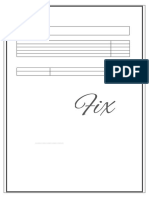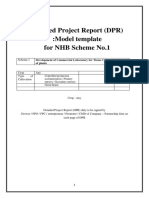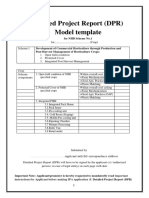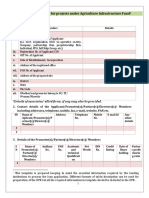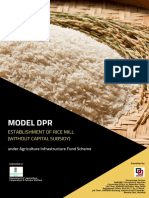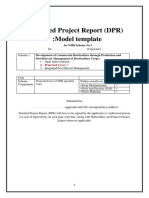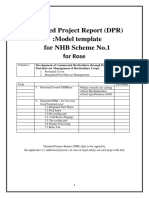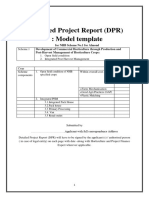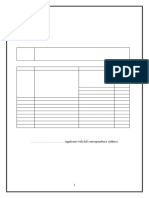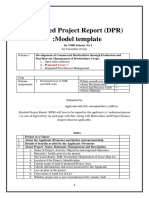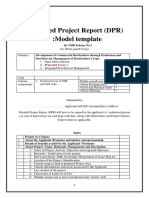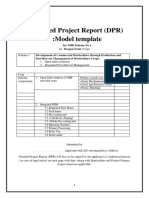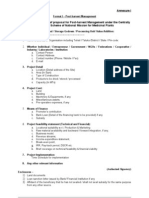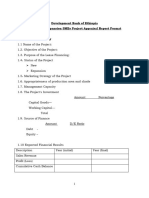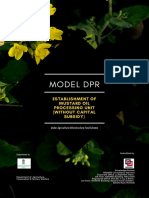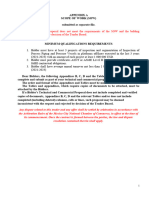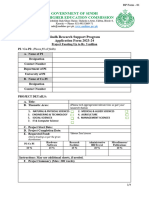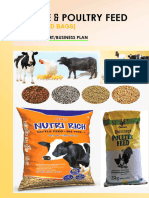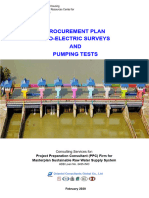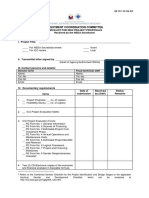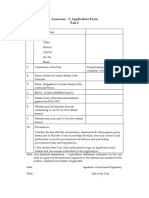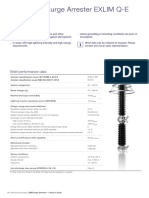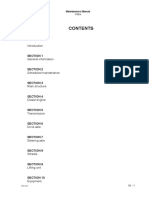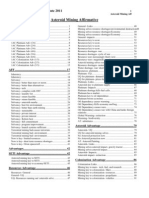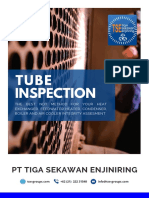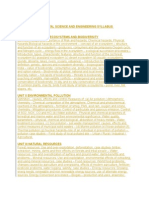Project Report Sample Copay
Project Report Sample Copay
Uploaded by
thanikaivimalCopyright:
Available Formats
Project Report Sample Copay
Project Report Sample Copay
Uploaded by
thanikaivimalOriginal Description:
Original Title
Copyright
Available Formats
Share this document
Did you find this document useful?
Is this content inappropriate?
Copyright:
Available Formats
Project Report Sample Copay
Project Report Sample Copay
Uploaded by
thanikaivimalCopyright:
Available Formats
Detailed Project Report (DPR)
Model Template for NHB Scheme No.2
Scheme.2 Capital Investment Subsidy Scheme For Construction/ Expansion/
Modernization of Cold Storage for horticultural produce and products.
Nature of Project Tick mark
Construction (New) – Type-2 CS
Expansion-Type- 2 CS
Add on Stand-alone component-Type-2 CS
Tick
mark
1. Type-2 basic for multiple temperature and product use, more than 6
chambers of < 250 MT
2. CA Tents
3. Programmed Logic Controller(PLC) Equipment
4. Dock Leveller
5. Warehouse Development & Regulatory Authority (WDRA)/ Negotiable
Warehouse Receipt (NWR) system, equipment.
6. Specialized Packging
7. Reefer Container (Multi-modal)
8. Advanced Grader
9. Stacking system
10. Retail Shelf
11. Alternate Technology
Submitted by
……………………………. (Applicant) with full correspondence Address
Detailed Project Report (DPR) will have to be signed by the applicant (s) / authorised person
( in case of legal entity) on each page with date -along with Horticulture and Project Finance
Expert wherever applicable.
DPR Model Template for NHB Scheme N 2 Page 1
Index
S. Description Page No.
No.
Project at a Glance
1. About the Applicant /Promoter and his/her entrepreneurship
2. Details of benefits availed by the Applicant / Promoter
3. About Project -Name, Rationale, Management and Description
4. Market viability
1. Raw material commodities & their characteristics
2. Raw material Availability
3. Market Viability
4. Business Model
6 Technical Viability
1. Design and Technical standards of Cold storage, Technology and
add on components and their compliance
2. Automation if any
3. Cold storage Protocols
7. Food Safety
8 Traceability
Annexure
1 Checklist
2 Civil Works, Technology, Standards and Compliance
3 Proposed stages in NHB Scheme implementation
Declaration/ Certification by Experts and Charter Engineers
Declaration/ Certification by Applicant
Check list
List of documents to be submitted
DPR Model Template for NHB Scheme N 2 Page 2
Project at a Glance
1. Applicant (s) / Legal entity Name
2. Constitution / Applicant nature / beneficiary
3. NHB Scheme for which DPR is made: 2.1/2.2/2.3/2.4/2.5.
4. Project Activity proposed
5. Project Site Address with Postal Code and Police Station Name
6. Land ownership: Owned or on registered lease for minimum of 10
effective years from the date of IPA. In other words ideally one should
have 11 Years of lease including a processing period of 1 Year from
the time of application for Technical feasibility.
7. Market viability Yes/No
1. Whether the project is located in the crop cluster/ hub/ belt Yes/No
2. Availability of raw material assured
3. Market Analysis is undertaken
4. Business model
5. Name of commodity proposed to be stored
6. Number of persons serviced Growers
Traders
Exporters
Processors
Others
8. Financial viability Yes/No
1. Project economic period/ economic life
2. Total Project Cost of the proposal
3. Project completion period ( in months)
4. Expected Implementation Commencement
timeline Completion
5. Total Eligible Project cost as assessed by the Applicant as per
NHB guidelines
6. Bank/ Financial Institution identified for Term loan
7. Proposed Means of Promoters contribution (in Lakh Rs.) & %
Finance Bank Term loan (in Lakh Rs.) & %
Un secured loan (in Lakh Rs.) & %
Total
8. Likely Employment generation (man days)
9. Gestation/Moratorium period
10. Projected Key Current Ratio other than export units
Financial Parameters CR-Export units
IRR /BCR
DPR Model Template for NHB Scheme N 2 Page 3
DSCR*
Average DSCR
Debt to Equity Ratio i.e DER
TOL/TNW
Promoters Contribution
Break Even Point
Security Coverage Ratio
Repayment period
9. Technical viability Yes/No
1. Annual through put Capacity
2. Number of Chambers
3. and Technical their Yes/No
4. Food Safety
5. Traceability
10. Employment generation Direct- regular per annum
In-direct – Man days per annum
DPR Model Template for NHB Scheme N 2 Page 4
1.About the Applicant / Promoter and his/her entrepreneurship
A. About Applicant / Promoter
1.1.In case of Individuals or Group of farmers (if applicable)
Individual
1. Name of Farmer / Entrepreneur/Individual/
Proprietor
2. Parents or spouse name of Individual
Group of Farmer growers / SHG- Promoters
1. Name of Group
2. Names of all members of group with their
father, mother/husband/ wife name
1.2.In case of Legal entity (if applicable)
Name / Title
1. Incorporation / Registration number / CIN & date of registration
2. Act under which Registered
3. Registering authority
4. Name of CEO/CMD/MD/
5. If it is FPO/ FPC/ Producers Co-op society / Growers Co-operative
Marketing federation- Please specify
6. If it is Reg. Society/ Company/ Corporation / Partnership firm / Proprietary
firm- Please specify
7. Name of Promoter (s)
8. Status of the promoter / applicant in the legal entity-please specify
9. Whether the promoter / applicant is authorised by the Legal entity- Yes/No
10. In case of Company/partnership firms / legal person
a. Certified copy of Company/Partnership incorporation/ registration
certificate issued by Competent Authority, as applicable
b. Certified copy of MoA/Bye Laws
c. Certified copy of Board of Directors Resolution duly passed and
authorizing signatory of application to apply for IPA
d. Certified copy of latest Audit Report, if applicable
i. (are to be made available in case the project and the
application is considered for processing.- State Yes/No
11. NGO- Specify details including registration No.
DPR Model Template for NHB Scheme N 2 Page 5
1.3.Government Institutions / Organisations—Please specify (if applicable)
(i) Marketing Board / Agricultural Produce Marketing Committee APMC
(ii) Municipal Corporation
(iii)PSU/ Agro-Industries Corporation
(iv) ICAR/CAU/SAU/ Government R&D Institution
1.4.Statutary registration (for both promoter and legal entity based on applicability)
a. PAN No
b. Aadhaar No. Yes/No
c. Udyog Adhaar No.
d. GST
e. Passport No.
f. Any other
1.5.Correspondence Address Postal Address with PIN code
Telephone
Mobile
Email id
Fax if any:
1.6.Project / Site Address
1.7.Social Category General / SC/ST
( In case of legal entity the OBC
CEO and Board of Directors Minority
social category is to be (Muslim/Christians/Sikhs/Buddhists/Parsis/Jains)
mentioned) In case of SC/ST applicants a Certified copy of
Caste Certificate issued by Competent Authority
is to be enclosed. In case of others a self-
declaration is to be enclosed.
1.8.Location: TSP / NE Region In case of TSP a self-attested copy of notification
/ Hilly States is to be enclosed.
1.9.Gender Male / Female/Transgender
1.10 Details of Contact Person
(i)
DPR Model Template for NHB Scheme N 2 Page 6
B. Applicant/ Promoters’ Entrepreneurship:
1.10.CV / Biodata of Applicant (s) / Promoter (s) (Authorised by legal entity) in brief: ( If
applicants are more than one, all are to provide their CV / Biodata)
a. Name of Applicant/ Promoter:
b. Fathers & Mothers name:
c. Spouse Name
d. Date of Birth
e. Place of Birth (village/town/city, District and State)
f. Permanent Address:
g. Educational qualification (Higher Secondary, Under graduation Degree and above)
Education Name of Board / Year of Remarks
Metric/ U education / College / Pass
specialisation University/
Institute
h. Horticulture and project proposal specific Trainings if any undergone
Training Duration and Institute with Purpose for undergoing
Period address training
i. Current profession with details of Turn over, Accomplishments if any.
j. Previous profession during the last 5 Years with details of Turn over,
Accomplishments if any
k. Experience- General and Horticulture & Cold storage
a. General (Other than Horticulture) specify the activity, establishment/ Office,
location etc.
b. Horticulture-General: State specific activity- crop production, PHM etc.
including project site, area, number of years, accomplishments etc.
c. Horticulture-Experience in proposed activity/ Cold Storage: provide the name
of establishment/office, location, number of years, specialisation etc.
l. Any information that establishes the applicants’ entrepreneurship (Should be able to
enclose evidence during Market & Financial Viability stage and during JIT):
DPR Model Template for NHB Scheme N 2 Page 7
1.11. Registrations with any Government Agency if any
Government Agency Provide registration No. details with date
and location of registration
a. Warehouse Development &
Regulatory Authority (WDRA
b. MSME
c. MSME/SSI
d. Any other
1.12.Commitment by the applicant: In case the project is approved for pre-IPA technical
feasibility, the promoter / CEO/CMD and technical personnel ( minimum two persons)
should undergo a 2 Weeks (min.10 working days) project specific training programme as
found appropriate / approved by NHB.
DPR Model Template for NHB Scheme N 2 Page 8
2.3.In case of a Partnership firm/ Company / Legal person
a. Whether the proposed activity is covered under the objectives as per Memorandum of
Association (MoA) & Rules explicitly: If so please provide the Article and Rule in
verbatim.
b. Professional history of Legal entities Farmers Producer Organisations (FPOs), Self
Help Groups, Partnership/ Proprietary Firms, NGOs, Companies (as a Board of
Director), Corporations, Cooperatives, Co-operative Marketing federations/
Government Institutions.
c. Management structure if it is a company/ firm etc depicting the position of the
applicant.
DPR Model Template for NHB Scheme N 2 Page 9
2.Details of benefits availed / proposed to be availed by the applicant- either individually
or as a member of Association of growers, Group of Farmer Growers/consumers, Farmers
Producer Organisations (FPOs), Self Help Groups, Partnership/ Proprietary Firms, NGOs,
Companies (as a Board of Director), Corporations, Cooperatives, Co-operative Marketing
federations from (i) NHB and (ii) other Ministries/ organisations of Central Government and
(iii) State Governments including NHM for Horticulture related projects.
Note: The beneficiary should be truthful. In case any information is received later on at any
stage about his/her availing of benefit which is not disclosed hereunder will entitle NHB to
reject the current proposal and recover the funds if already released.
2.1.In this / proposed project and location:
1. Whether the proposed project proposal has been submitted for consideration under
any State Government or Central Government Scheme for financial grant? If yes give
details.
2. Whether any subsidy has been availed from the Board, other Central Govt.
organisation or State Government for the same activity on the same piece of land,
khasra/ Gat/Dag/ etc either in his / her own name individually or in the name of
his/her family members or through any legal entity in which he/she is the beneficiary
either in the same location, project. - Yes/ No. If Yes, Please provide details
Constitutio Ministr Schem Project Project Land Eligibl Total Current
n– y/ e code & Locatio Surve e subsid status of
Organi Name Activit n y No Project y/ project-
Individuall y cost Operational
y or in any sation grant /
form underutilise
( Rs.in d / closed
lakhs) ( Rs.in
lakhs)
DPR Model Template for NHB Scheme N 2 Page 10
2.2.In earlier / any other Project (s) : Either in his / her own name individually or in the
name of his / her family members or through any legal entity or in any form or constitution,
in which he / she is the beneficiary either in the current proposed project location or any other
location.
2.2.1.From NHB : Whether any assistance in the form of soft loan and subsidy has been
availed earlier from the National Horticulture Board? If yes, give details thereof
Year Scheme Project Project Land Eligible Total Current status
Name code & Location Survey Project subsidy of project-
Activity No cost /grant Operational /
availed underutilised /
closed
2.2.2.From Central Government- Ministries / Organisations:
Year Scheme Project Project Land Eligible Total Current status
Name code & Location Survey Project subsidy / of project-
Activity No cost grant Operational /
availed underutilised /
closed
2.2.3.From State Governments:
Year Scheme Project Project Land Eligible Total Current status
Name code & Location Survey Project subsidy of project-
Activity No cost /grant Operational /
availed underutilised /
closed
DPR Model Template for NHB Scheme N 2 Page 11
2.3. Operational status of earlier projects under NHB scheme and other Central Ministries
and State Government.
Ye Organisa Activit Dates As on Annu Expo Profita Rema
ar tion / y for date al rts if ble or rks /
Ministry which Subsi Project Comme Project Turno any loss Reaso
which assista dy comple nced Operati ver makin ns
released nce is recei ted producti onal (of g
assistanc availe ved on status previo
e d& us
code (Runnin Year)
g or
Closed)
* in case of completed projects and where proposals envisioning expansion/ modernisation
are proposed, Annual Reports and Audited Statement of Accounts of the last 3 years are to be
made available along with Bank appraisal during Market and Financial Viability stage both
online and offline.
2.4.Please provide map of earlier / other subjects and this project- Key map of project land
showing project details and land boundary details
DPR Model Template for NHB Scheme N 2 Page 12
2.5.Provide the following details:
a. Have you ever been refused / denied subsidy claim from NHB, NHM, APEDA,
NCDC, MoFPI? If Yes please provide details of (i) Project code, (ii) Name of
Applicant, (iii) Address (iv) Project activity etc. and the reason for such refusal /
denial:
b. If you were a recipient of Government subsidy, have you / your Bank/FI ever been
asked to refund the subsidy / call back ? If Yes please provide details of (i) Project
code, (ii) Name of Applicant, (iii) Address (iv) Project activity etc. and the reason for
such refusal / denial:
Attention:
1. In case the project application is considered for Pre-IPA, the applicant shall have to
enclose No Objection Certificate from State Government / State Horticulture Mission that
there is no duplication of funding for the project and the applicant shall also submit self-
declaration that he/she is not availing government subsidy / grant / assistance from any
other ministry.
DPR Model Template for NHB Scheme N 2 Page 13
1.About the Project, Rationale, Management and Description:
4.1. About the Project
1. Name of the Project
2. Correspondence Address:
3. Address of Project Site :
4. Nature of Project
Nature of Project
Construction (New) – Type-2 CS
Expansion-Type- 2 CS
Add on Stand-alone component-Type-2 CS
5.Project Activity and Scheme components (Should be as per NHB scheme latest scheme
guidelines- please verify):
Tick No of Capacity
mark Unit
1. Type-2 basic for multiple temperature and product use, more
than 6 chambers of < 250 MT
2. CA Tents
3. Programmed Logic Controller(PLC) Equipment
4. Dock Leveller
5. Warehouse Development & Regulatory Authority
(WDRA)/ Negotiable Warehouse Receipt (NWR) system,
equipment.
6. Specialized Packging
7. Reefer Container (Multi-modal)
8. Advanced Grader
9. Stacking system
10. Retail Shelf
11. Alternate Technology
6. Produce /commodity to be handled / stored
7. Objectives of the project
8. Expected outcomes of the project
9. Socio-economic benefit to the Rregion /District / State
1.2. 3.2.Rationale / Justification for the project:
(should also include availability of raw material, its area, production and its volume, quality,
existence of similar projects, linkage with markets, consumption areas, technology etc.)
DPR Model Template for NHB Scheme N 2 Page 14
3.2.1. Rationale
1.3. Project Site/ Land details:
1.3.1 Proposed Project Area ( Sq.mt)
A Name of Owner of land proposed for the
project as per Land Revenue Records
Whether title of the land is clear in the name
of applicant and is free from any litigation
How Title is Ancestral
derived Purchased (with details
of date)
Encumbrances if any
B Name of the Owner in case of joint ownership Survey/ Area in Share
Gat Sq.mt / Ha
/khasra
No etc.
Whether land boundaries are demarcated for Yes/No
the applicant clearly.
Whether land is in possession of the Applicant
C In case of Partnership
1. Whether land is owned by Partnership Yes/No
firm or jointly by its partners
2. NOC: If land is owned by one of the
partner, an undertaking by land owner
is required stating that he/she will not
withdraw, sale or transfer his/her land
during currency period of the project
Whether land is in possession of the Applicant
D In case of Lease
1. In case the land is that of leased,
Registration details of the said leased
land in the office of Sub-Registrar
2. No.of Years of lease
DPR Model Template for NHB Scheme N 2 Page 15
3. Whether lease is entered in RoR Yes/No
Whether land is in possession of the Applicant
E Whether land is mortgaged? If yes provide
details of mortgagor and mortgagee
3.4.Location of the Project- Identification (Longitude, Latitude, Altitude, Village, GP,
Block, District, State), Area, Number of growers.
1. Location Address
2. a. Survey/Khasra/ Dag/ Other No
3. b. Habitation/ Village
4. c. Gram Panchayat / Urban body
5. d. Block / Urban body
6. e. Sub-Division
7. f. District
8. g. State /UT
9. Location Longitude, Latitude &
Altitude
10. Total Area of land owned (ha)
11. Total Area proposed for project (ha)
Google map with coordinates:
3.5.Current usage of land of proposed Project Area
Proposed Project Current usage
Survey / Dag Nature of Area (ha) Activity / Area (ha) Mortgage
etc.No land Crop Yes/No
Dry/ If Yes with
Irrigated/ whom
Waste land
DPR Model Template for NHB Scheme N 2 Page 16
3.6.Current infrastructure and assets possessed by the Applicant:
Category Asset Name Year of Make Capacity Cost
Purchase
Fixed
Assets
Operating
Assets
3.7.Lay out plan of the project/ Map of Farm / production/ Operations unit / project land
showing project details and land boundary details including with fire, effluent treatment and
traffic movement within the campus.
3.8.Conversion of Land Use (CLU) if applicable
Whether Land in possession of the applicant is with/ without approval for industrial
use/Whether CLU permission for the project has been received from competent
authority: If Yes- Please provide details of the authority approved with full
designation, address contact numbers and email id, approval No. and date
3.9.Whether project site is part of production belt / cluster / hub ? If yes, provide details
of working relations with other farmers
DPR Model Template for NHB Scheme N 2 Page 17
4.8. Rationale for project site selection / Location advantages and disadvantages
3.11.Compliance of project site safety (Soil condition- water logging, industrial waste
and effluents/Run off and contaminated water) including seismic sensitivity
Connectivity :
Road National High way
connectivity-
State Highway
Distance from
Fright Corridor
Golden Quadrilateral
Rail connectivity
Air connectivity
Water ways
Market
connectivity
Supply side suitability: Raw material Catchment area
Whether project site is part of production belt / cluster / hub ? If yes, provide
details of working relations with other farmers
Road National High way
connectivity-
State Highway
Distance from
Fright Corridor
(Range) Golden Quadrilateral
Rail connectivity
Air connectivity
Water ways
Market
connectivity
Map of Catchment Area:
Demand side suitability
Proximity and connectivity of project site to major consumption centres /Mandies
Demand centres Names Distance from the proposed site
Agriculture Produce
DPR Model Template for NHB Scheme N 2 Page 18
Market Committees -
APMCs / Mandies
Tier-1, 2 and 3 cities
Map of consumption Centres
Other Merits/ Advantages:
4.10. Component wise Justification: (Use the applicable information)
Tick No of Capacity
mark Unit
1. Type-2 basic for multiple temperature and product use, more
than 6 chambers of < 250 MT
2. CA Tents
3. Programmed Logic Controller(PLC) Equipment
4. Dock Leveller
5. Warehouse Development & Regulatory Authority
(WDRA)/ Negotiable Warehouse Receipt (NWR) system,
equipment.
6. Specialized Packging
7. Reefer Container (Multi-modal)
8. Advanced Grader
9. Stacking system
10. Retail Shelf
11. Alternate Technology
4.11. Cost components / activities of the proposed Project
Capacity NHB norms for
/ Proposed calculating EPC
Project Units/
Sub- items Area/ Total
Component Numbers
spacing Expenditure
Etc.
1 2 3 4 5 6
Land Capacity
Land and site based:
In case of Cold
development
Storage/ CA
Building & Civil PEB Structure and
Structures Civil construction
DPR Model Template for NHB Scheme N 2 Page 19
cost Technology
Cost of racking / induction and
mezzanine Modernisation -
Eligible Project
structures Cost (EPC) is
Insulation system based on
Refrigeration system capacity except
Condensers for components
Air handling system which are part
of CS / CA
Ventilation system
Plant and stores.
CO2 , Ethylene
Machinery
scrubbing systems Capacity and
Humidity generation Pro-rata basis:
and control systems In case of
Piping Refrigerated
Transport
Stacking system Vehicles
Bins
Material
Battery operated
Handling
pallet trucks Crates, Component
Equipment based:
Pallets Reach Truck,
Forklift etc etc. For Add on
components
Sorting
Grading
Infrastructure
Refrigerated
Refer container
Transport
Floor Cleaning
Tools and equipments,
Equipment Vacuum Cleaners
etc.
Laboratory
Process
Monitoring Gauges
Control &
PLC etc
Automation
Water softener etc.
HT power line
Utilities
Transformer and
voltage stabilizers
Backup system DG sets
for power Solar Power etc.
Energy
efficient and Solar
technology to VFD
reduce carbon HRW
foot print
Total
DPR Model Template for NHB Scheme N 2 Page 20
Operational planning:
1. Name of Manager (working directly under the
applicant / CEO) if any.-optional. -Qualification and
experience of the proposed personnel in managing
cold chain projects.
2. Operations: (viz., loading, unloading, grading, sorting,
cleaning, weighing, packing etc.)
i. Own / custom hiring
ii. Own / outsourcing
iii. Own / outsourcing
iv. Own / outsourcing
v. Own / outsourcing
vi. Own / outsourcing
vii. Own / outsourcing
viii. Own / outsourcing
ix. Own / outsourcing
x. Own / outsourcing
Profile of Agency executing erection of Cold Storage / CA etc.
1. Name of agency providing technical know-how and
turn key basis with full address of its Hq and its local office
2. CIN / Company Incorporation No.
3. GST No.
4. CEO of the Agency
5. Contact person Name and contact numbers
6. Technical Manpower available (Desirable)
7. Number of years of experience (Desirable)
8. No of plants set up till date during the last 5 years in the State (Desirable)
9. Turnover of the Agency (Desirable)
10. Whether firm has been blacklisted ever by any government or (Desirable)
corporate firm
DPR Model Template for NHB Scheme N 2 Page 21
3.15. Quality of Services of Agency executing erection of Protected Structure/ Post
Harvest Infrastructure (based on project / applicability etc.
1. Hardware: Guarantee offered Guarantee Period &
conditions if any
1.
2.
3.
2. Hardware: Warranty offered Warranty period &
conditions if any
1.
2.
3.
3. Services: Supervision and After sales service Free service Period
4. Others
5.
6.
7.
8.
10.13. Project Implementation period in case of approval:
(Commencement to Completion…….Months)
Activities Months Approximate Date Expected Date of
required of Commencement Completion
Acquisition of Land
Development of Land
Building & Civil Works
Plant & Machinery
Placement of order
Delivery at site
Erection of equipment
Electrical & Instrumental
Erection
Trial runs &
Commissioning
Fixing of Insulation
Arrangement of Power
Arrangement of Water
Commercial Operation
Note: Time limit for completion of project is 18 months.
DPR Model Template for NHB Scheme N 2 Page 22
10.14. Month Wise Operational Chart Number of days of operation
Product Jan Feb Mar Apr May Jun Jul Aug Sept Oct Nov Dec
Commodity-1
Commdity-2
Commodity-3
Loading period
Holding Period
Sales Period
DPR Model Template for NHB Scheme N 2 Page 23
Availability of Manpower (Skilled Labour, Expertise etc. Required, Already available, Gaps
and the management in an Year.)
Managerial- Proposed
S.No Designation Education Experience Numbers Purpose Remarks
Qualification
CEO
Administration
Customer
Development
Labour
management and
Welfare
Others
Technical-Proposed
S.No Designation Education Experience Numbers Purpose Remarks
Qualification
Operations Head
& Supervisor
Safety Officer
Inventory auditor
Rodent & Pest
Management
officer
MHE & HAVC
maintenance
head
Skilled and Unskilled Labour
Operations/ Skilled Labour Unskilled labour Gap
activity Requirement Availability Requirement Availability S US
Number No.of Number No.of N D N D
Days Days
Gap Management if any:
DPR Model Template for NHB Scheme N 2 Page 24
10.15. Employment Generation per annum
No.of man days / Annum
Permanent man power -Permanent (on rolls)
Casual / Temporary
4.17.Facilities, External Infrastructure and Utilities
(Power, Fuel, Water, Plant and Machinery, Effluents treatment etc.)- Required, Already
available, Gaps and the management.
Utility Requirement Remarks
Power Likely Daily power requirement
Likely Annual Power requirement
Proposed Source of Power
Access to Power is assured or not
Alternative Source of Power in case of
breakdowns
Whether renewable alternate energy to power is
under consideration
Water Source – Ground Water /Surface Water
Existing or New source
Whether NOC has been taken from CGWB / State Yes/No
Government Ground water regulation authority-
Water measurement systems is planned
Daily Water requirement
Whether water harvesting is planned Yes/No
Water productivity parameters proposed if any
Quantity of effluents likely
Water treatment plant if any proposed Yes/No
Fuel Access to fuel to power- Generators- Yes/No
Nearest fuel depot
Effluent Facility and method adopted for effluent
treatment treatment.
Market
connectivity
10.16. SWOT Analysis
1 Strengths
2 Weaknesses
3 Opportunities
4 Threats
DPR Model Template for NHB Scheme N 2 Page 25
MARKET VIABILITY
1.Raw material commodities and their characteristics
S.No Name of Commodity Characteristics
proposed to be stored
Physical Biological Chemical
Horticulture produce are special as they respire even after harvest.
For single commodity storage
1) Harvesting time (morning/evening hours when temperature is low ) and pre cooling
requirement of product
2) Minimize mechanical injury during harvest/handling prior to storage
3) Requirement of operations like desapping in case of mango
4) Climacteric or non-climacteric nature of produce
5) Requirement of blanching ( to inactivate enzymes in case of frozen peas)
6) Temperature and humidity ranges for safe storage of produce
7) Chilling injury temperature ranges
For Multi commodity storage
In addition to above factors of single commodity, following considerations are needed
1) The commodities mix should be such that there is match of temperature and humidity,
levels of ethylene production and sensitivity for all commodities
Examples of ethylene producing and ethylene sensitive products:
Ethylene producing: e.g. apples, avocado, bananas, pears, peaches, plums,
tomatoes
Ethylene sensitive produce: e.g. lettuce, cucumbers, carrots, potatoes, sweet
potatoes
2) Odour transfer should be avoided by proper selection of compatible produce
Examples of odor transfers which should be avoided:
apples/pears with celery, cabbage, carrots, potatoes or onions
celery with onions or carrots
citrus with strongly scented vegetables
pears/apples with potatoes à former acquire unpleasant taste
green pepper will taint pineapples
onions, nuts, citrus, potatoes should be stored separately
DPR Model Template for NHB Scheme N 2 Page 26
2.Raw Material Availability
1.1. Identification of Catchment Area/ Cluster: Radius :
……………………………………….
(Not to exceed 100 Km radius in production areas)
State District Approximate Distance from Major Crops
Proposed Site Available
Area
*: Catchment area should be either Sub-Division/ Block/ Taluk etc.
In exceptional cases the radius can be beyond 100 Km to be satisfied upon physical verification.
2.2. Map of Catchment Area
1.2. Production of targeted horticulture crops in the state
Crop.1 Crop.2 Crop.3 Crop.4
Crops Area Production Area Production Area Production Area Production Area Production
(ha) (MT) (ha) (MT) (ha) (MT) (ha) (MT) (ha) (MT)
Source: http://agricoop.nic.in/
1.3. Production of targeted horticulture crops in the District (s)
Crop.1 Crop.2 Crop.3 Crop.4
Crops Area Production Area Production Area Production Area Production Area Production
(ha) (MT) (ha) (MT) (ha) (MT) (ha) (MT) (ha) (MT)
Source: Multiple sources: District Horticulture Office/ Marketing office etc.
1.4. Production of targeted horticulture crops in the in catchment areas
Crop.1 Crop.2 Crop.3 Crop.4
Crops Area Production Area Production Area Production Area Production Area Production
(ha) (MT) (ha) (MT) (ha) (MT) (ha) (MT) (ha) (MT)
Source: Horticulture Dept.
DPR Model Template for NHB Scheme N 2 Page 27
Viability of Cold Storage / Infrastructure:
Catchment Total Deduction of Total No.of Cold Existing Gap between
crop Area* Production 30% # of Storage able Storages Cold columns 4 and 6
production for Quantity Storage
fresh (col.3-4) Capacity
consumption
1 2 3 4 5 6 7
*: Catchment area should be either Sub-Division/ Block/ Taluk etc.
#: % of fresh consumption is variable which may be specified by the applicant.
1.5. Seasonality matrix of the commodities
Horticultur Jan Feb Mar Apr May June July Aug Sept Oct Nov Dec
e
commodities
Lean Season
Peak Season
Details of similar projects in the neighbourhood and the installed capacity
Demand and Supply issues specific to project area:
1.6. Throughput Analysis
Surplus available in catchment area/
Planned
Product Annual raw material requirement proposed radius =
Capacity
Deduction of 30% # of production for fresh consumption
Note: please choose your targeted crop
DPR Model Template for NHB Scheme N 2 Page 28
3.Market Analysis
General information: At State / UT level
1.7. Clusters/ Zones
Crop clusters in the State (Mandatory)
Name of District No.of villages No.of farmers Total Area Source*
Crop
1
2
3
4
Source: APEDA/ MoFPI/ State Government
1.8. 5.2.4.2.Crop Agricultural Economic Zones in the State / UT, if any (Desirable)
Crop AEZ District No.of villages No.of farmers Total Area Source*
1
2
3
4
Source: APEDA
Project specific information
Proposed usage of Cold Storage / CA
Purpose Proportion (%) No.of potential growers / traders in the
catchment area
1. Rental for (Growers
produce)
2. Rental for Traders
3. Storage by Owner of Cold
Storage for own trading
4. Contract Farming
100%
Commodities proposed for Storage:
Commodity / Crop Variety / Hybrid Share of Availability of Source of Protocol
commodity Protocols (R&D Institution/
Company)
DPR Model Template for NHB Scheme N 2 Page 29
1.3. Target Market- As per applicability
Domestic or International. In case of International market, the applicant has to refer APEDA export
requirements and should specify compliance appropriately with in the document. In case of
domestic market specify the intended market
1. Quality grades/ specifications/ kinds of products and their targeted Domestic/
International market.
2. Existing / Proposed Market linkages:
3. MOUs/ Contract documents / undertakings/ LoA if any
4. Target consumption centres/ key domestic markets
5. Export targets/ Plans if any
6. In case of export, details of volume to be exported / export destination / statutory
norms of export destination should be provided in the DPR.
1.4. Market Competition
Major cold storages available in the cluster with respective capacities.
Availability of Storage facilities in the Project area (Please attach the list)- For the latest 3 years.
Year Commodity Low cost storage structures Cold storage CA Storage
No. Capacity Capacity No. Capacity Capacity No. Capacity Capacity
utilisation utilisation utilisation
Multiple sources: https://nccd.gov.in/# ; http://nhb.gov.in/onlineclient/rptmiscrops_midh.aspx and District Horticulture
Office/ ICAP/ Cold Storage Association.
Note: Capacity utilisation data may be provided if available.
Availability of Storage facilities in the project District.
Year Commodity Low cost storage structures Cold storage CA Storage
No. Capacity Capacity No. Capacity Capacity No. Capacity Capacity
utilisation utilisation utilisation
Multiple sources: https://nccd.gov.in/# ; http://nhb.gov.in/onlineclient/rptmiscrops_midh.aspx and District Horticulture
Office/ ICAP/ Cold Storage Association.
Availability of Storage facilities in the State
Year Commodity Low cost storage structures Cold storage CA Storage
No. Capacity Capacity No. Capacity Capacity No. Capacity Capacity
utilisation utilisation utilisation
Multiple sources: https://nccd.gov.in/# ; http://nhb.gov.in/onlineclient/rptmiscrops_midh.aspx and District Horticulture
Office/ ICAP/ Cold Storage Association.
DPR Model Template for NHB Scheme N 2 Page 30
Gap Analysis in Project Area:
Surplus Commodity / Storage Storage Gap Remarks
produce capacity capacity
required in the available in the
area area
Demand and Supply Analysis
Unit Surplus of Existing cold stores for Gap Remarks
Horticultural the current year#
crops*
Nos. capacity
Catchment
Area
District
where
project is
located
Cluster
State
*: The last 3 years average #: as per the latest available data.
Remarks: (Market reach and specific utilization opportunity if any)
Source for data: State Directorate/ Horticulture/ Agriculture/Marketing office/ District & other local
offices/ Any other reliable sources/ Cold Storage association etc.
1.5. Trade Potential (National & International)
Domestic Market Potential
S.No. Name of major Products / Name of targeted Market (s) Justification
commodities / consumption centres
1.
2.
3.
*Comments on Demand and Supply gap if any
International trade Potential
(Collect from APEDA Agri-exchange website at http://agriexchange.apeda.gov.in/; including
product profile, statistics and market intelligence sites esp. International trade and Global
Analytical report in brief to the extent of relevance; may also refer DGCIS
sitehttp://www.dgciskol.gov.in/for more information)
DPR Model Template for NHB Scheme N 2 Page 31
Name of Major Exporting % share in Major % share in CAGR rates /
major Countries global Importing global growth Indicator
products market Countries market
5.2.9 Price variation of Commodities at State / UT Capital or at a Major Fruit &
Vegetables/ Flower Market
A.At local Market
Local Market: 1 Unit=Rs. Per Qtl/MT/Kg
Year Jan Feb Mar Apr May June July Aug Sept Oct Nov Dec
Source: Concerned APMC / Marketing Board website or http://agmarknet.gov.in/
If no reliable source is available, the above data may be collected from District Marketing /
Horticulture Officer
B.At nearest / Major Terminal Market
Major Terminal Market: 2 Unit=Rs. Per Qtl/MT/Kg
Year Jan Feb Mar Apr May June July Aug Sept Oct Nov Dec
Source: Concerned APMC / Marketing Board website or http://agmarknet.gov.in/
If no reliable source is available, the above data may be collected from District Marketing /
Horticulture Officer
DPR Model Template for NHB Scheme N 2 Page 32
C.Projected prices of project produce (if Possible)
Market: ………………………… Unit=Rs. Per Qtl/MT/Kg
Year Jan Feb Mar Apr May June July Aug Sept Oct Nov Dec
Source: Could be applicants’ own assumption / horticulture expert etc.by giving justification
DPR Model Template for NHB Scheme N 2 Page 33
5.2.10.Balance sheet of commodity in the Catchment Area / District/ State (Desirable
Data/ Voluntary)
Year: Qty: 000Tons
Jan Feb Mar Apr May June July Aug Sept Oct Nov Dec
Stored/
Carry in
Fresh
Production/
Arrivals
Imports
Availability
In LT
Storage
Consumption
Exports
Post
Production
losses
Total Usage
Carry out
Source:
Note:
Whether transportation infrastructure is available.
1. Mode of transportation / arrangement:
2. Whether cold chain facility available locally if so details of service providers and
contact person name.
DPR Model Template for NHB Scheme N 2 Page 34
Value chain Analysis
Value Addition scope/ potential
DPR Model Template for NHB Scheme N 2 Page 35
Existing Trade Policies
6.7.1 State Policies
6.7.2. National Policies
6.7.3. International Policies (tariff and non-tariff barriers, Sanitary and Phyto-
sanitary requirements and APEDA /Spices Board regulations in case applicants
market include exports)
DPR Model Template for NHB Scheme N 2 Page 36
4.Business Model
(Should include commodities, rental/trading/mix, procurement plan, market, finances, unit cost,
profitability, SWOT, uniqueness, vision, etc.)
DPR Model Template for NHB Scheme N 2 Page 37
Financial Viability:Viability of The Project:
10.1. 5.3.Financial Viability of the Project
( To be prepared and certified by Project Finance Expert on each page)
Due Deligence Status:
S.No. Date of Due Deligience Please tick Remarks
1 Examination of CIBIL report Yes/No
2 Credit rating / scoring is done Yes/No
3 Whether name of
promoters/company appearing in
the list of- Yes/No
a) RBI defaulter list Yes/No
b) RBI willfull defaulter list Yes/No
c) ECGC SA list
4 a)Verfication of CERSAI (Central Yes/No
Registry of Securitisation Asset
Reconstruction and Security Interest)
b) In case of company whether Yes/No
financial data verfied with ROC .
Detailed financial analysis of the investment has been carried out based on estimated costs (as per
quotations and established cost norms) and projected revenues (based on industry norms).
10.2. Project cost Component Wise vs NHB Norms (Please refer NHB scheme
guidelines)
S. No. Name of the scheme Capacit Proposed Cost Total Cost as
component y/ per NHB Norm
Units
1. Cold Storage Unit type- MT
2 for multiple
temperature and
produce use , more
than 6 chambers of
<250 MT)
1.CA Tents Tick No of Capac
mark Unit ity
2. Programmed Logic Controller(PLC) Equipment
3. Dock Leveller
4. Warehouse Development & Regulatory Authority (WDRA)/
Negotiable Warehouse Receipt (NWR) system, equipment.
5. Specialized Packging
6. Reefer Container (Multi-modal)
DPR Model Template for NHB Scheme N 2 Page 38
7. Advanced Grader
8. Stacking system
9. Retail Shelf
10. Alternate Technology
11.3.1. Land and Site development& General Civil works
Description Area Unit Rate Total cost (in Rupees)
Land
Land development
Total
11.3.2. Building
S.No Description Basis Area Unit Rate Total cost (in Rupees)
A Technical Building As per quotation /
LS / As per
estimation
Civil work (foundation, plinth &
flooring)
Pre-feb structure
Insulation
Plumbing & Internal Electrification
Fire fighting
Racking System
Plumbing & Internal Electrification
Others
B Non Technical Building
Toilet Block / office and others
11.3.3. Non-Building
S.No Description Basis Area Unit Rate Total cost (in Rupees)
11.3.4. Plant & Machinery
S. Description Unit Basis Unit Amount Taxes Total
No. Cost (Rupees)
Refrigeration system No. / As per quotation /
Capacit LS
y/
length
Condensers
Air handling system
Ventilation system
DPR Model Template for NHB Scheme N 2 Page 39
CO2 and Ethylene scrubbing
systems
& control systems
Humidity generation
Piping
PLC and Process control
Others
Other Add on Components- for each a separate table
S. No. Description Qty Unit Cost Amount ( Rupees) Taxes Total
Sub Total
11.3.5. Utilities
Particulars Unit Basis Qty Unit Cost Cost Taxes Total
1 Electricals
2 Water
3 Steam
Others
Sub-total
11.3.6. Miscellaneous fixed assets
Particulars Basis Qty Unit Cost Cost Taxes Total
1 Office Furniture & Fixture
2 Firefighting equipment etc.
3 Sub-Total
Sub-total
Others
Particulars Unit Basis Qty Unit Cost Cost Taxes Total
1
2
3
Sub-total
11.3.7. Pre-operative expenses
Particulars Basis Unit Unit cost Total
DPR Model Template for NHB Scheme N 2 Page 40
1
2
3
4
DPR Model Template for NHB Scheme N 2 Page 41
Summary of Project Cost
Item Project Cost Max. possible
NHB support
(self-appraisal)
1. Land & Land development
2. Technical building
3. Non-Technical building
4. Plant & Machinery
5. Add-on components
6. A
7. B
8. C
9. Other components
10. Utilities
11. Misc.Fixed Assets
12. Pre-operative expenses
Total
11.3.8. Means of Finance (Rs.in Lakhs)
S.No Item Components
1 Promoters share
2 Bank/FI Term loan
3 Un secured
loan/VCA
Total
11.3.9. Information on subsidy available under different schemes:- (For information)
1. Subsidy from NHB
2. Subsidy from State *
3. Subsidy from Centre *
4. Subsidy from other *
sources
Total
Hypothecation Security Details:
5.3.4.About Bank/ FI: Name of the Bank/FI, branch and its code identified for Term loan
and Rationale
Name of Bank/ FI
Bank/FI Branch Address
Bank/FI Branch contact Number
DPR Model Template for NHB Scheme N 2 Page 42
IFSC code
DPR Model Template for NHB Scheme N 2 Page 43
5.3.6 Projected / existing operational profitability of the Project : (Rs. In Lakhs)
Estimated projections
Y1 Y2 Y3 Y4 Y5 Y6 Y7 Y8
Capital
Reserves
Intangibles
Tangible Net
Worth
Net Working
Capital
Current Ratio
Net Sales
Op. Profit
Net Profit Before
Tax
Net Profit After
Tax
TOL/ TNW
Debt-equity ratio
Depreciation
Dividend
Retained Profit
Justification for the above (wherever figures are on higher side)
NOTE:- In case of existing business / project, the promoter has to provide the audited data
for the last three years apart from estimated and projected data for covering the entire
repayment period.
DPR Model Template for NHB Scheme N 2 Page 44
5.3.7 Project Financing:
1) Per Kg cost of storage of commodity for one season ( to be calculated by showing unit
cost towards – loading & unloading, Electricity and fuel charges, Administrative
charges, Selling charges, Repair and Maintenance, Insurance charges, Weight loss
etc)
2) Rate of Interest :
3) Percentage of Term loan against total project cost
4) Internal Rate of Return (IRR):
5) Cost of Production and Profitability (Annexure)
6) Yield and Sales Chart (Annexure)
7) Proposed Balance Sheet: (Annexure)
8) Proposed Cash flow Statement for repayment period (Annexure)
9) Proposed Profit & Loss Account: (Annexure)
10) Proposed Repayment of Term loan and Schedule (Annexure)
11) Break even Analysis (Annexure)
12) NPV (Net Present Value)
13) Economic Rate of Return
14) Depreciation
DPR Model Template for NHB Scheme N 2 Page 45
5.3.8 Sensitivity analysis of the project.
Base Case 2018-19
(First Full
Year of
Operation)
Case I Decrease in capacity utilization by 10%.
Case II Decrease in Sales by 10%.
Case III Increase in Raw Material Cost by 10%
Base Case Case I Case II Case III
PBIDT
PBT
PAT
Min DSCR
Max DSCR
Overall
DSCR
DPR Model Template for NHB Scheme N 2 Page 46
5.3.9 Key Financial Parameters for the proposal:
Sl. Ratio Benchmark As calculated by Project Finance Expert
No.
1styr 2ndyr 3rdyr 4thyr 5thYr
1. Current Ratio 1.25:1
other than export
units
2. CR-Export units 1.10:1
3 IRR /BCR
4 DSCR* 1.50:1
5 Average DSCR
6 Debt to Equity 3:1
Ratio i.e DER
7 TOL/TNW 4:1
8 Promoters 25%
Contribution minimum
9 Break Even Point Lower the
% is better
10 Security More than
Coverage Ratio 100% of
Loan
Amount
11 Repayment Up to 7
period Years
excluding
moratorium,
but not to
exceed an
overall
tenor of 10
years
*: is indicative and is variable subject to Bank
DPR Model Template for NHB Scheme N 2 Page 47
5.3.10 Statement of Assets & liability as on……...
1. Immovable Assets
(Rs. In lakh)
Sl.No Description Extent Location Face value Market value
1 Land
2 Building
3 Plant & machinery
4 Commercial plots
2. Movable Assets
Sl.No Description Modle Face value Market value
1 Car/Scooter/Truck/Bus/Mobile
phone
3. Bank/FI balances and cash
Sl.No. Name of the institutions Date of Face value Market
opening value/Present
value
4. Shares & debentures
Sl No Name of the Date of Face value Market value
Company/Institutions purchase
5. Investment in business & other associates concern
Sl No Name of the Date of Face value Market value
Company/Institutions Investment
Total assets……............
1. Liabilities
Sl.No. Nature of the loan Name of the Date of loan Face Market value/
institution value Present value
Total liabilities…….....................
Net of assets & liabilities…….....
Date: Signature of the Promoter/Guarantors/Directors /partner
DPR Model Template for NHB Scheme N 2 Page 48
5.3.11.Risk Analysis & Management
A. Promoters & Management Risks:
B. Project Completion and Operational Risk:
C. Other Risks:
Risk Management
Excess production / Glut situation in
Market
Crop failure
Price volatility-low prices
Pests and Diseases in Cold Storage
Technical failure
Power failure
Natural calamities- fire, cyclone, Floods
etc.
5.3.12.Record keeping/ Maintenance proposed
DPR Model Template for NHB Scheme N 2 Page 49
5.Design and Technical standards of Cold Storage, Technology and Add-on
Components and their compliance
Component : Cold Storage Type-2
Sr. No. Contents Page no.
1. Basic Data Sheets for Cold Storage and Add on Component
a. Identification of the Applicant
b. Project Milestone
c. Project Identification
2. Data Sheet for Cold Storage Type-2
i) Commodity Storage requirements
ii) Chamber sizing and information
iii) Enclosed Ante Room and Handling Area
iv) Facility Covered Areas
v) Building and Constructions details
vi) Insulation and Vapor Barrier Details :
Option 1 Expanded Polystyrene Sheet (EPS)
Option 2 – Composite PUF Panels/Rigid RPUF
vii) Storage Chamber insulation and Details
viii) Cold Storage Doors and Air Curtain/Strip Barrier
ix) Heat Load Estimation input
x) Fresh Air Ventilation System
xi) Heat Load calculation of cooling system – Summary
xii) Cooling System Configuration – Mechanical Refrigeration
xiii) Compressor Rack Details
xiv) Condenser Details
xv) Cooling Tower Details
xvi) Pressure Vessels
xvii) Evaporators/Air Cooling Units (ACU)
xviii) Electrical Installation
xix) Material Handling procedure
xx) Safety provisions : Mandatory
xxi) Energy Saving Equipment and Measures
xxii)Summary of estimated Electrical operating Load
xxiii) Estimated Performance Parameters of Proposed Cold Store
xxiv) Brief description of any other technologies or infrastructure
used
xxv) Drawings, Heat Load calculations and Technical details of
Equipments
xxvi) Codes and Standards Followed
DPR Model Template for NHB Scheme N 2 Page 50
Note: The above design, infrastructure and facilities should meet and comply with the Minimum
System standards notified by the Government of India- Ministry of Agriculture and Farmers Welfare,
th
DAC&FW vide No.F.No.45-64/2010-Hort Dated 15 May 2015.
The weblink :https://nccd.gov.in/PDF/NCCDGuidelines2014-15.pdf
DPR Model Template for NHB Scheme N 2 Page 51
FORM 1: IDENTIFICATION OF THE APPLICANT
A: Identification of the Applicant
Name of Promoter(s)
Name of Commercial Entity/Enterprise
Type of Commercial Entity
(Proprietorship/Partnership/
Pvt. Ltd. I Ltd. I PSU I State
Undertaking)
Postal Address of Entity :
Tel/Fax Mob No. E-mail:
Presently activity in brief
Name of Contact Person Phone:
Mobile No.
Email:
B. Project Milestone:
Date for application for subsidy
Date of Project Start
Amount of Bank Loan Sanction
Date of Bank Loan Sanction
Last Approval/Inspection Status
Name of Approving Body
PAN Number registered with Bank
If Project Commissioned Date of Completion Certificate Issuing Authority
DPR Model Template for NHB Scheme N 2 Page 52
C: Project Identification: Pre - Cooler / Cold storage / Pack - House / Reefer Vehicles / Retail Shops
Name of Project
Modernization
New Project Expansion
Type of Project (Please tick)
Location of Project Address: Village/Town
(Complete Address)
DISTRICT: STATE:
Manpower Employed
(on rolls / on contract)
What Business model is
used (rental, captive, part
of supply chain service,
mixed)
Years in Business New
Components of Project 12. Type-2 basic for multiple temperature and product
submitted (please tick) use, more than 6 chambers of < 250 MT
1. CA Tents
2. Programmed Logic Controller(PLC) Equipment
Checklist for individual Data
Sheets Submitted
3. Dock Leveller
4. Warehouse Development & Regulatory Authority
(WDRA)/ Negotiable Warehouse Receipt (NWR)
system, equipment.
5. Specialized Packging
6. Reefer Container (Multi-modal)
7. Advanced Grader
8. Stacking system
9. Retail Shelf
10. Alternate Technology
Type of Products to be Temperature Zones
Handled (Frozen, Chill, Mild- <-18 ⁰C 0-10 ⁰C 10-20 ⁰C
Chill)
DPR Model Template for NHB Scheme N 2 Page 53
Data Sheet for Cold Storage Type 2
i. Commodity Storage Requirements
Description Standard Parameters Proposed by Promoters Deviation if Any
Type of commodities / These are multi commodity and
Produce multiple temperature control
storage, hence promoter to
specify type of commodities /
produce to be stored
Total number of >6 Chambers *.
chambers
Storage capacity of ≤250 MT
Chambers
* However, small capacity cold stores of less than 500 MT normally suits small
entrepreneur / farmers group’s need , such projects be assessed on a case to case basis.
ii. Chamber Sizing and information
Chambers Chambers Chambers Chambers Chambers
Details
Group-1 Group-2 Group-3 Group-4 Group-5
Product Types
Storage Conditions
0 0 0 0 0 0
a) Temperature – C 0 to 2 C 0 to 2 C 0 to 2 C 4 to 5 C 10 to 12 C
b) Relative Humidity 90-95% 95-100% 65-75% 90-95% 85-90%
%
Dimension of CS
chambers in each group
(L X W X H) m
Storage Capacity of each
chamber group (Cubic
Meters )
Storage Unit used
(Pallets, Big Bins,
Cartons, Crates, etc.)
Stacking System Used
( Over stack bins/
Racking/ others)
Total Heat load
calculated per chamber
group (kW)
Total Refrigeration
capacity per chamber
(KW) with safety and
compressor operation
hrs.
DPR Model Template for NHB Scheme N 2 Page 54
iii. Enclosed Ante Room & Handling Area
Details Standard Parameters Proposed by promoters Deviation if any
Ante Room / Handling Area With fork lift width ≥ Informatio 0
Temp. C
(L x W x H ) - m 4.5m and temperature n
0
≤ 20 C
Refrigeration Load ( KW) Per Chamber group
Number of access Doors Atleast ≥ 1. Provide
door numbers and
dimension. If operation
by Fork lift , the door
dimension shall be
2400 mm (W) x 3000
mm (H)
Dock Leveler System Provide details of
protected loading,
unloading platform
details.
Minimum quantity ≥ 1
and dimensions of the
dock shelter may
be3400 mm (W) x 3500
mm (H) and overhead
door size 2200 mm (W)
x 3000 m (H).
iv. Facility Covered Areas
Particulars Proposed by Promoters Deviation if any
Standard Parameters
2
Cold Storage Area Height 8 m to ≤ 12 m. Area ( m )
and Height
Area would depend upon
proposed storage capacity
of Chamber and may be
Height (m)
calculated =
Storage capacity(MT)/ 3.4
2
Ante Room – Area Area ( m )
and Height
Height (m)
2
Receiving Room Area ( m )
Area and height
Height (m))
DPR Model Template for NHB Scheme N 2 Page 55
2
Machine Room Height ≥ 4.6 m Area ( m )
area and height
Height (m))
2
Generator room Height ≥ 4.6 m Area ( m )
area and height
Height (m))
2
Admin Block area Height ≥ 3.6 m Area ( m )
and height
Height (m))
v. Building & Constructional Details
Details Standard Parameters Proposed by promoters Deviation if any
Type of Building Construction Promoter to Specify
( Load bearing construction) whether building
construction is RCC civil
OR
PEB with insulated
panels
Promoter to Specify
External
whether walls are
Walls
constructed with civil
External walls / Internal walls/ works with insulation
partition walls of cold store slabs fixed on the walls Internal
chambers as IS: 4671 / IS: 13205 Walls
OR
Pre- insulated panels Partition
are used. Walls
Roof / Ceiling construction Promoter to describe
external roof
construction and
whether insulation
slabs fixed on ceiling as
IS: 4671 / IS: 13205
OR
Pre- insulated panels
are used.
Lighting Fixtures in cold chambers Fluorescent /CFL / LED
lights with IP-65
fixtures
DPR Model Template for NHB Scheme N 2 Page 56
External/Compound Area Promoter to specify External/
construction details of Compoun
external and compound d Area
area including provision details
of parking area
Parking
area
details
Others
vi. Insulation and VAPOR Barrier Details
Option- 1:Expanded Polystyrene Sheet (EPS)
Proposed by Deviation if any
Type of Insulation Standard Parameters Promoters
External Wall Thickness 150 mm
No of two layers each layer 75 mm
layers thick with staggered
Partition wall Thickness 75 mm both sides of
partition wall
No of Single layer
layers
Ceiling Thickness 150 mm
No of two layers each layer 75 mm
layers thick with staggered
Floor Thickness 125 mm
No of two layers (75 mm+50mm)
layers with staggered
Density 16± 2 kg/ m ³
0
Thermal Conductivity (k-value) at + 0.036 W/m K
0
10 ⁰C (mean temperature) in W/m K
2 2
U value (W/m ⁰k) for 100mm thick 0.36 (W/m ⁰k)
insulation
Thermal diffusivity -6
1.5- 1.70 x 10
( m²/h)
Relevant IS Code IS:4671
Vapor Barrier Specification
a) External Wall/ Internal Wall / Aluminum foil
Ceiling (50 micron)
b) Floor 250 Micron thick Polythene
sheet
Specification on Cladding
DPR Model Template for NHB Scheme N 2 Page 57
a) External Wall/ Internal Wall / 0.5 mm thick (tct) Micro
Ceiling Ribbed pre painted GI sheet
in off white colour (RAL-
9002) conforming to IS:
14246:95.
b) Floor a) Tar-felt of thickness ≥ 2
mm thick (ISCode:
1322-1993) 1ith 10%
overlap on top
insulation with hot
blown bitumen .
b) ≥ 100 mm thick Tremix
flooring above Tar-felt
with M-25 grade RCC.
Relevant Is Codes:
Expanded Polystyrene for thermal IS: 4671
Insulation
Code of practice for application of IS:661
thermal insulation in CS
Option-2: Composite PUF Panels/ Rigid RPUF
Type of Insulation Standard Parameters Proposed by Deviation if any
Promoters
Specification on Composite PUF Composite PUF Panel
Panel for walls and ceiling cladded with 0.5 mm thick
(tct) Micro Ribbed pre
painted GI sheet in off white
color (RAL-9002) conforming
to IS:14246:95 and with
tongue and groove joints
with or without cam-locks .
External Wall panel Thickness 100 mm
Partition wall panel Thickness Min. 50mm
Ceiling panel Thickness 100 mm
Floor Thickness 100 mm thick
No of layers Two ( 50 mm + 50 mm ) with
staggered joints
Density 40 ± 2 kg/ m ³
0
Thermal Conductivity (k-value) at + 0.023W/m K
0
10 ⁰C (mean temperature) in W/m K
2 2
U value (W/m ⁰k) for 100mm thick 0.23 (W/m ⁰k)
insulation
Thermal diffusivity -6
0.38 – 0.41 x 10
( m²/h)
Relevant IS Code IS:12436
Vapor Barrier Specification
a) Floor 250 Micron thick Polythene
sheet
DPR Model Template for NHB Scheme N 2 Page 58
Specification of cladding on Floor
insulation
a) Floor a) Tar-felt of thickness ≥ 2
mm thick (IS Code:
1322-1993) 1ith 10%
overlap on top
insulation with hot
blown bitumen.
b) ≥ 100 mm thick Tremix
flooring above Tar-felt
with M-25 grade RCC.
Relevant Is Codes:
Pre-formed rigid polyurethane foam IS: 12436
for thermal insulation
Code of practice for application of IS:661 / IS 13205
thermal insulation in CS
Others
vii. Storage Chamber Insulation & Details
Chamber Ceiling Thickness External wall Internal wall Floor insulation Internal dimension
number (mm) thickness(mm) thickness(mm) thickness(mm) ( L x B x H) m
1
Standard Standard insulation parameters are provided at para vi - Option-A and Option –B above.
Parameters Promoter to follow these.
Deviation if To be listed here.
any
DPR Model Template for NHB Scheme N 2 Page 59
viii. Cold Store Doors & Air Curtain/ Strip Barrier
Chamber Number of Doors Door Opening Thickness Strip curtain or Opens to
number (wxh)m ( mm) & U Air Curtain (Ante room or out
value in - side)
20
W/ m K
1
Standard a) Door opening size if operation with fork lift :
Parameters
2400 mm (W) x 3000 mm (H) x 100 mm thick and manually operated sliding type.
b) If operation manually :
Door may be either Sliding type or Hinged type of size : 1200 mm (W) x 2000 mm /
2100 mm (H) x 100 mm
c) Air Curtain :
Air curtain shall be able to isolate cooling or heating and should assure dust- proof
deodorizing and insect – proof characteristic and size as door opening requirement.
d) Strip Curtain
Overlap shall be 25% minimum
Deviation To be listed here.
if any
ix. Heat Load Estimation Input
Type of inputs Chamber Group – 1 Chamber Group -2 Chamber Group - Chamber Group -4
3
DPR Model Template for NHB Scheme N 2 Page 60
Product Stored
0
Storage Temp. C
Relative Humidity in
%
Air Circulation rate
in (CMH)
Specific Heat of
product in kj/ Kg
Heat of Respiration
during loading/ pull
down in mW/ kg
Heat of Respiration
during Holding/
storage in mW/ kg
Daily door opening
Estimated mass of
products to be
loaded and unloaded
daily
( MT)
Ante Room are
conditions (⁰C)
Special provisions
( describe)
Standard Parameters
Thermal Properties of Foods may be used as given in Table- 3 & Table-9 of Chapter -9-
Ashrae .Handbook-Refrigeration (SI) -2006 and or WFLO hand book.
Deviations if any
DPR Model Template for NHB Scheme N 2 Page 61
x. Fresh Air Ventilation System
Type of inputs Standard Parameters Proposed by Promoters Deviation if any
Number of Fresh air 6/4/2
changes
Brief Description of Mechanical CO 2
Fresh air Ventilation extractor with energy
system. recovery system with
atleast 70% efficiency
CO2 Concentration 2000-400
control range ( PPM)
Monitoring & Control CO2 sensors for
Instrument regulation of ventilation
system including
temperature and RH
indicator & controllers,
preferably overall control
of all parameters with
PLC control system.
Explain heat recovery Heat recovery wheel
system if used. (HRW) preferably
desiccant based rotary
heat exchanger offering
both sensible and latent
efficiencies equally.
xi. Heat Load calculation of Cooling System-Summary.
Description Standard Parameters Proposed by Promoters Deviation if any
Dry Bulb temperature Peak conditions are Summer-
( DB) normally based on summer; DB
Wet Bulb Temp.(WB) hence specify summer DB & Summer
WB Temperature. – WB
Summer
Note: The temperatures are location specific based on ISHRAE/ASHRAE Hand Book.
Description Details Deviation if any
Building Dimensions ( External)
Specify
LX W
Total Capacity of the Storage ( MT)
Number of the Chambers
During Deviation if any
Refrigeration Load Peak Load (kW)
Holding(kW)
Transmission Load (kW)
DPR Model Template for NHB Scheme N 2 Page 62
Product Load including respiration load
(kW)
Internal Load Lighting Load
(kW)
Occupancy Load
Infiltration load (KW)
Ventilation / Fresh Air refurbishment
load (KW)
Equipment load – Evap. Fan Motor , MHE
etc. (KW)
Total Load of Ante Room (KW)
Total Load (kW/24 hrs.)
Total Load with safety margin and
compressor operation
Particulars Operation Period Standard Parameters Proposed by Deviation if
Promoters any
Compressor Pull down Period ≤ 20 Hrs. / day
operation -
Hours/ Day Holding Period ≤ 20 Hrs. / day
Defrosting Period ≤ 2 Hrs. / day
Multiplier ( Safety 5-10%
Factor)
Total Refrigeration Load Peak Period (kW) Holding Period (Kw)
Cooling System Design Detail
xii. Cooling system Configuration: Mechanical Refrigeration ( Describe)
Description Proposed by Deviation if any
Standard Parameters Promoters
Type of Refrigerant Ammonia/ Ammonia with
Propylene Glycol as secondary
refrigeration. In case of HFC,
use R-134 a, R- 404a etc.
Total Refrigeration system
Capacity (kW)
Type of System DX type with Gravity Feed or
HFC refrigerant and Liquid
DPR Model Template for NHB Scheme N 2 Page 63
Overfeed System with
Ammonia liquid pump
Type of Compressor Reciprocating / Screw
Compressors as per load
requirement and type of
system used.
Type of Capacity Control Automatic in Step
Specify unloading steps in Based on Compressor size
%
a. For 2 cylinder 50% and 100%
compressor
b. For 3 cylinder 33%, 67% and 100%
compressor
c. For 4 cylinder 50%, 75% and 100%
compressor
d. For 6 cylinder 33%, 67% and 100%
compressor
e. Screw 10% to 100%
Compressors
Type of Condenser Atmospheric/ Evaporative
/Water cooled / Air Cooled
Cooling Towers (if Natural Draft/ Induced draft ,
applicable) preferably with FRP body.
Type of Evaporators/ Air a) Ceiling Suspended/Wall
Cooler mounted type. with SS-304
Coil & aluminum fin with fin
spacing 6.25 -8.5 mm and
axial fan preferably blowing
fans with air throw as per
chamber size, unit casing-
GS sheet for Ammonia
application with VFD
b) For HFC refrigerant use
Copper coil.
Type of Defrosting Air/ Water/ Hot Gas / electric
Humidification System & Preferably With Coil only.
Control However, in case humidifier is
used, provide complete details
with operational parameters.
Refrigeration Equipment Details
xiii. Compressor /Rack Detail
Compressor/Racks Standard Parameters Proposed by Promoters Deviation if any
Quantity 3 No. each of 50% capacity (2
Working during Loading/ Pull
down and one preferred as
DPR Model Template for NHB Scheme N 2 Page 64
standby) in case of ammonia.
For HFC , either rack system of
compressors or individual
condensing units for each
chamber if load requirement/
chamber is less and cost
effective.
Make & Model
RPM
Operating Operating parameters to be
Parameters decided with cold store
temperature and RH
0
requirement with SST as 2 C
0
& 38/40 C DST during pull
down and SST to be decided
based 4 TD during holding for
maintaining RH ≥ 85%.
Refrigeration Capacity
at 2˚C SST & 38/ 40˚C
DST (during loading /
pull down
Power consumption
in BkW at 2˚C SST &
38/ 40˚C DST (during
loading / pull down
Refrigeration Capacity
at operating
parameters (during
Holding)
Power consumption
in BkW at -
operating
parameters (during
Holding)
Total Connected
Motor
( KW)
Remarks/Standby
DPR Model Template for NHB Scheme N 2 Page 65
xiv. Condenser Details
(Air / Water cooled condenser with recommendedparameters)
a) For Atmospheric: Consider 20 -21 KW heat rejections / stand of 6 m Long and 12
nos. 50 NB pipe i.e. 72 m long pipe / stand ,
b) Consider water circulation @ 6 LPS / 100 KW of heat rejection
Condenser Qty. Operating Condenser Electric Total Remarks
Type, Make & Parameters Heat Fan/Pump Electric Working/Standby
Model Condensing Rejection Motor Rating Power
Temp. (CT) Capacity (kW) (kW)
WBT, water (kW)
in/out Temp
(⁰C)
xv. Cooling Tower Details (if applicable)
(Recommended FRP Type)
Cooling Qty. Operating Cooling Fan &Pump Total Electric Remarks
Tower-Type, Parameters Tower capacity Power Working/Standby
Make & Condensing Capacity (CMH/LPS) & (kW)
Model
Temp. (CT) (kW) Motor (kW)
WBT,
water
in/out
Temp (⁰C)
xvi. Pressure Vessel
a) Recommended storage volume of HP Liquid Ammonia Receiver = 7.85 L/ KW of
refrigeration load,to be designed and testing of the pressure vessel should comply
with ASME Sec VIII Div1.
b) Refrigerant Circulation for overfeed / pump circulation 1:4
Description Type- Refrigerant Operating Description Total Holding
Horizontal Temp. & Shell, Dish Refrigeration Volume
/ Vertical Pressure Ends & load
Nozzles
Lowpressure
High pressure
DPR Model Template for NHB Scheme N 2 Page 66
xvii. Evaporating Cooling coil Unit/Air Cooling Units (ACU)
ACU Type Nos. Operating Cooling Air Flow (CMH) & Material of Fin Total Fan
Make & Parameters Capacity Face Velocity Coil Tubes & Pitch Electric Power
Model Evap. (SST) & (kW) (m/s) Fins (mm) (kW)
TD * (⁰C)
Note: Air cooling units shall be provided with VFD
0 0
( *TD is the Temperature difference between Evap. (SST) C & Return Air temp. C at coil inlet).
xviii. Electrical Installation
Description Details
Total Connected load (kW)
Estimated power requirement at peak load
period (kW)
Estimated power requirement at Holding Load
period (kW)
Capacity of Transformer (KVA)
Size of Capacitor
Make & Capacity of standby D.G. Sets (nos.
and kVA)
Main electric power distribution panel equipped with change over facility shall be provided
Control panel for refrigeration system, lighting & fan, APFC, Water supply & firefighting shall be
provided
Electrical earthing shall be provided
xix. Material Handling procedure
Procedure Details Proposed by Deviation if any
Promoters
Material Handling Procedures & Manual/Conveyor
equipment
Capacity of Mechanized belt conveyor
(kW) if any-Rating of motor
Any Other Device please specify
DPR Model Template for NHB Scheme N 2 Page 67
xx. Safety provisions: Mandatory
Descriptions Standard Parameters Proposed by Deviation if any
Promoters
Fire Fighting equipment Attach fire safety
installed as per Fire safety standards of State fire
standards of State Fire department
Department
Handling measures for 1. Ammonia sensors in
Refrigerants and Leaks cold chambers near
installed ACUs & machine
room;
2. Emergency
ventilation for
machine room;
3. Safety release of
refrigerant to water
sump;
4. Ammonia masks;
First aid kit;
Instructions for
handling
emergencies.
5. Handling measures
As per code of safety
IS 4544
Safety devices - LP! HP cut Solenoid based cutouts,
outs, safety valves, shut off Ammonia valves as per IS
valves etc. installed 11132, Switches near all
cold store doors and
alarms located in common
public areas, as per NHB
norms
HP Pressure Vessel Water Sprinkler pipe
Emergency lighting in Cold Solar PV cells with
Chambers & others areas batteries & controller
installed
Lightening arrestors installed As per regulations
Machine room ventilation Exhaust Fans
system for self containing
Any other safety provisions
(describe)
DPR Model Template for NHB Scheme N 2 Page 68
xxi. Energy Saving Equipment & Measures
Details of Energy Standard Parameters Proposed by Promoters Deviations if any
Saving Devices
Light Fixtures Lighting Fixtures
Fluorescent /CFL/LED with
IP-65 protected fixtures
Natural Lighting for With glass windows on
general areas walls
VFD/ Electronic Capacity control using
Technology for compressor cylinder
fans/Compressors unloading
Refrigerant Controls
and Automation PLC panel with data logger
as per NHB norms
Air Purger' Manual purger valves at
receiver and condenser
Power Factor Automatic Power Factor
Controller Controller (APFC)
Energy recovery Energy wheel with 70 %
recovery ,
PLC Control & Data To be
Acquisition
Any other
Components
xxii. Summary of estimated Electrical operating Load
Equipment ( Peak Period) - BkW Holding Period - BkW
Compressors
Condenser Pumps
Air Cooling Units
Internal Lighting
Liquid Pump
Total Operating Load ( BkW)
DPR Model Template for NHB Scheme N 2 Page 69
xxiii. Estimated Performance Parameters of Proposed Cold Store
Parameters Standard Parameters Proposed by Promoters Deviation if any
Peak Holding Peak Holding
Period Period Period Period
Coefficient of Performance (COP) >3.5 >3.2
of the cold store unit
Power Consumption (kWh/day)
considering diversity factor 0.8
Prevailing Electricity Cost (Rs/
Kwh)
xxiv. Brief Description of any other technologies or Infrastructure used
Details Proposed by Promoters
Refer Trucks operated (if any)
Specialized Packaging Lines (if any)
PLC Automation (if any)
Dock levelers systems (if any )
Alternate energy options (if any )
Modern Pack –house (if any)
Others
xxv. Drawings, Heat Load calculations and Technical details of Equipments
Details Provided by Promoters (Yes/No) Deviation if any
Plan & layout of the
proposed cold store unit
approved by registered
Architect
Detailed heat load
calculation sheets of the
proposed cold store unit in
accordance to be
prescribed technical
standards and guidelines
duly approved by a
qualified engineer
Detailed Technical Data
sheet of following
equipment
a. Refrigeration
compressor
b. Evaporating Coil
DPR Model Template for NHB Scheme N 2 Page 70
CA TENT
Sl.No Component:: CA Tents Description (refer sample sheet)
1 Name of Manufacturer
2 Material Used
(describe)
3 Number of layers /
thickness
4 Dimensions
5 Capacity of Gas
cylinder / CA
6 Air sealing mechanism
(desribe)
7 Atomphere control &
analysis
8 Pressure relief value
9 Piping connections
DPR Model Template for NHB Scheme N 2 Page 71
10 Number of Air
Sampling lines
11 Internal fan/Blower
rating
Component: PLC Control System for Refrigeration Plant:
# Component: Programmed LogicControls Description
A Design & Construction
1. Name of Provider
2. Processor system
3. Number of Input (IU)/ Number ofOutput
(OU)
4. Type of Report generation
B Refrigeration Plant Controls Refrigeration Control included: Yes/No
5. Compressor
6. Compressor rack control
7. Condenser fans
8. Evaporator fans
9. Water Circulation pump
10. Liquid ammonia circulation pump
11. Glycol PHE and Circulation Pumps
12. Defrost control
13. Liquid Level Controls
Describe Controls of levels switches ,
14. valves , relays, breaks
15. Other if any
C. Room parameters Controls
16. Temperature
17. Relative Humidity
18. CO2 , O2 and Ethylene levels
19. Any Others
D Plant Safety Operation
20. Compressor Protection
21. Evaporator Fan Control
22. High Condensing Pressure Alerts
Maximum and minimum temperature
23. alarm
24. Back up pressure probe
25. Discharge temperature Monitoring
26. Protection against low suction super heat
DPR Model Template for NHB Scheme N 2 Page 72
27. Any Other
Component : Dock Leveler System
Component: Dock Recommended Offered by promoter Deviation if any
S.Nos. Leveler System Parameters
A DOCK LEVELERS
1. Name of Manufacturer
2. Type of operation Hydraulic / Mechanical
3. Ramp- Platform
4. Number of cylinders
Platform size (W x L)
5. meters.
Max vertical Lift up &
6. down in mm
7. Load capacity (tons)
Plinth height of facility
8. (meters)
9. Control Panel
Standard safety
10. provisions
11. Emergency stop switch
Dock pit dimensions
12. (meters)
13. Power Consumption
B DOCK DOORS
Manufacturer and
14. model
Dimension of Door
15. opening
Loading area
o
16. temperature ( C)
Insulation-material,
17. thickness and U value.
18. Safety Provision
C. DOCK SHELTER
Name of Manufacturer
19. and model
20. Dimensions
21. Sealing Material & type
22. Bumper
23. Safety Provision
i. WDRA – NWR EQUIPMENT
Component: Recommended Offered by promoter Deviation if any
S. WDRA-NWR Parameters
Nos. Equipment
1 Computer Type / Manufacturer &
Quantity Model and
hardware /
software
DPR Model Template for NHB Scheme N 2 Page 73
configuration for
each to specified
2 Printer type Manufacturer &
Model to specified
3 Type of produce Specify here type of
cargo that shall be
handled and annual
quantity that will be
issued NWR
4 AMC Promoter to specify
AMC details
5 WDRA accreditation Promoter to specify
application number,
date of applying
and the date on
which accreditation
was granted
6 Specify here
volumetric storage
Storage capacity (m3) capacity available.
SPECIALISED PACKAGING
Sl.No Component:: Details (refer sample sheet)
Specialised Packing
1 Name of Manufacturer
2 Feeding line
3 Strong Grading unit
DPR Model Template for NHB Scheme N 2 Page 74
4 Weighing Machine
5 Final Packing
6 Traceability system
7 Labelling System,
Printing
8 Throughput capacity
9 Total Power
consumption (KW)
REEFER CONTAINER
Sl.No Component:: Reefer Description (refer sample sheet)
Contanier
DPR Model Template for NHB Scheme N 2 Page 75
1 Container dimensions
2 Insulation details-
thermal conductivity
and thickness
3 Tare weight (Kgs)
4 Gross weight (Kgs)
5 Temperature recording
type
6 GPS System
7 Refrigeration
capacity (Kw)
8 Refrigernat used
9 Fresh air exchange
10 Diesel / elecric
auto-switching
DPR Model Template for NHB Scheme N 2 Page 76
11 Air flow cum /
hr(CFM)
12 Temperature control
precision +/-0C
13 Name of Manufacturer
14 Year of manufacture
15 Any design
enhancement
Component : Advanced Grader
S. Nos. Component: Advanced Grader Description
1 Produce
2 Weight Sorting / Grading
3 Colour Sorting / Grading
4 Optical/Acoustic DiameterGrading
IQS (Intelligent
5 qualitySorting/Grading)
6 Safety Precautions
7 Output capacity (units/hr. ortons/hr.)
8 Power consumption (kW)
9 Name of manufacturer
10 Year of manufacture
Component: Stacking System
S. Nos. Component: Stacking System Description (Refer sample datasheet)
A Bins
DPR Model Template for NHB Scheme N 2 Page 77
1 Name of Manufacturer
2 Material of construction
3 Load capacity (kg)
4 Storage volume (L x B x H)
5 Stacking Height (meters)
B Pallets
1 Material & working load(kg/tons)
2 Dimensions (L x B x H) m
3 No of cartons per pallet
4 Type of access
C Racking System
1 Name of Manufacturer
2 Type of racking system
3 Design over view Rack
4 Material Construction
5 Number of tiers
6 Net Storage capacity
7 Load bearing weight per position
RETAIL SHELF
Sl.No Component:: Retail Description (refer sample sheet)
Shelf
1 Name of Manufacturer
2 Type
3 Produce to be handled
4 Capacity (m3)
5 Dimension-floor area
and height
6 Electronic used
(describe)
DPR Model Template for NHB Scheme N 2 Page 78
7 Temperature Range
8 RH Control
9 Lighting system (KW)
10 Total Refrigeration
capacity(kw)
11 Refrigerant used
12 Energy consumption
(KW)
13 Years in business in
food retail
ii. ALTERNATE TECHNOLOGY
S. Nos. Component: Solar Recommended Offered by Deviations if any
Photo Voltaic (SPV) Parameters promoter
1 Name of Manufacturer Specify manufacturer’s
name
2 Make and model no. Specify make & model
3 Total shadow free area
(m2), total area occupied Provide details of
by PV panels (m )2 shadow free south facing
area and total area
DPR Model Template for NHB Scheme N 2 Page 79
occupied by PV Panels in
( m2)
4 Total Load to be Provide details of loads
energized (kW and to be energized if any –
describe) not necessary when
connected to grid.
5 Storage battery capacity Provide total battery
(Ah) capacity that shall be
used to store the energy
generated in Amp- Hours
, if applicable
6 Battery Backup (hours) Provide details of
battery back up in hours
7 Grid interactive Provide Grid metering
rate for facility
8 Energy generation (kWh) Provide expected annual
/ monthly energy
generation in KWh.
9 Grid Electricity Provide details of
Availability (hours) number of hours
electricity is available at
the facility.
10 Total SPV Capacity (kW) Provide total SPV (Solar
Photo Voltaic) capacity
in KW.
11 Power of single PV panel Specify power in Watts
(Watt) and total number of single PV Panel and
of panels installed. total number of panels
installed.
12 Total array size (kW) Specify number of
panels in a single array.
Solar Thermal
Sl.No Component:: Solar Description (refer sample sheet)
Thermal
1 Name of Manufacturer
DPR Model Template for NHB Scheme N 2 Page 80
2 Make and Model No.
3 Type of System
4 Capacity (litres/day)
5 Type of Tank Material
and thickness
6 Insulation material
and thickness (mm)
7 Heat Exchanger
Available
8 Total number of
collector panel
9 Dimension per
collector panel (l x
w)
10 Total Area Covered
(m2) by collectors
11 Open Loop / Closed
Loop System
DPR Model Template for NHB Scheme N 2 Page 81
DPR Model Template for NHB Scheme N 2 Page 82
Thermal Banks
Sl.No Component:: Thermal Description (refer sample sheet)
Banks
1 Name of System
provider
2 Describe system
design
3 PCM material
4 Phase change
temperature (0C) and
latent energy (KW)
5 Application –
describe use planned.
6 Backup period (hours)
7 Mass of PCM (kgs or
tons)
8 Total Thermal Energy
Bank (KW)
9 PCM encapsulation
DPR Model Template for NHB Scheme N 2 Page 83
10 Time to fully Charge
the PCM
11 External energy input
(describe and
specifications)
DPR Model Template for NHB Scheme N 2 Page 84
VAPOUR ABSORPTION
Sl.No Component:: Vapour Description (refer sample sheet)
Absorption
1 Name of Manufacturer
2 Make and Model No.
3 Capacity (KW)
4 Refrigerant used
5 Absorbent used
6 Temperature of
Chilled water (0C)
7 Temperature of hot
water (0C)
8 Temperature of
condensate (0C)
9 Describe Heat Source
& heat engrgy (KW)
DPR Model Template for NHB Scheme N 2 Page 85
10 Inlet / outlet
Pressure drop (kPa)
11 Elecrical Consumption
12 Type of vapor
Absorption machine
13 System use (describe
total load required
and application of
this system)
xxvi. Codes & Standards Followed
Sl No Details Relevant Codes Complianceby
Promoters (Yes/No)
1 Building Design & Structures (Pre Engineered
Building)
a. b. Building Code IBC 2006
c. d. Design code AISC 2005
e. f. Tolerance Code MBMA 2002
g. h. Purlin code AISI 2001
i. j. Welding code ANS 2006
k. l. Wind Load & Seismic load IS 875 & IS A893-2002 &
Relevant Codes
2 Construction Materials Relevant IS Codes for various
construction materials
3 Thermal Insulation & Application IS 661, IS 12436 & IS 4671
4 Refrigeration Equipment & System Relevant IS code for
different equipment
5 Electrical & Mechanical System
a) PVC insulated cables (light duty) for - 694-1990, Part- I & II
working voltage up to & including
DPR Model Template for NHB Scheme N 2 Page 86
1100 volts
b) PVC insulated cables (heavy duty) for 1554-1988 Part- I
Voltage up to 1100 volts
c) Guide for marking of insulated 5578-1984
conductors
d) Code of practice for earthing 3043-1987
e) Recommendations on Safety 5216-1982 Part - I
Procedures and Practices in Electrical
Work - Part I: General
f) Recommendation on Safety 5216-1982 Part II
Procedures and Practices in Electrical
Work - Part II : Life Saving Techniques
g) Code of practice for selection, 10118-1982
installation and maintenance of Part I,II,III,IV
Switchgear and Control gear
h) Code of Practice for Electrical Wiring 732-1989
Installations
i) XLPE Cables for working voltage up to 7098- 1988 Part -I
and including 1100 Volts
j) Specification for Electric Power 5561- 1970
Connectors
k) Methods of Test for Cables 10810 - 1984
l) National Electrical Code SP-30
m) Others Equipment specific
codes for all items as per
list given in NHB – CS-
Type-01-2010 Standards
Project declares compliance with all mandatory codes and regulations are complied with
(Signed by applicant)
DPR Model Template for NHB Scheme N 2 Page 87
6.2.Automation Services if any
1) Measurement Systems
Parameter Instrument Frequency of Remarks
reporting
1. Air Temperature
2. Relative Humidity
3. Co2
4. Ammonia
5. Freon
6. Ethylene
7. Oxygen
8. Pathogens
9. Fire & Smoke detection
System
2) SMS & Email Alerts: The Authorized person of company will receive on instant SMS
and Email alert whenever there is movement of stock in our cold storage.
3) Online Stock details
4) Air monitoring SMS: The authorized person in your company will receive a daily
SMS on temperature and relative humidity at regular intervals.
5) Online Air Monitoring System: The authorized person in the company can view
online temperature and relative humidity of each chamber.
6) Monthly Inventory report: The authorized person in the company shall receive
product wise monthly inventory report.
7) Monthly Air monitoring Data logger sheet: The authorized person in the company
shall get temperature recording info of every hour 24X7 for that month.
8) Phone aap- Growers & clients have the privilege to check the temperature and Rh in
the storage of their stock at the press of a button in their phone.
9) Inventory Day report:- System generated day report across all location in one mail
is sent to the clients.
10) Weekly Inventory report: The authorized person in the company shall receive
weekly inventory report.
11) Weekly Space monitoring report: The authorized person in the company will get
space utilization report in which client get an idea about total allotted space, utilized
space & how much is vacant space.
DPR Model Template for NHB Scheme N 2 Page 88
6.3. COLD STORAGE PROTOCOLS- COMMODITY WISE
Commodity.1
Protocol ( R&D Institution/ Company)
developed by
Protocol details
Proposal by the
applicant
Deviation if any
with justification
Commodity.2
Protocol ( R&D Institution/ Company)
developed by
Protocol details
Proposal by the
applicant
Deviation if any
with justification
Commodity.3
Protocol ( R&D Institution/ Company)
developed by
Protocol details
Proposal by the
applicant
Deviation if any
with justification
Commodity.4
Protocol ( R&D Institution/ Company)
developed by
Protocol details
Proposal by the
applicant
Deviation if any
with justification
DPR Model Template for NHB Scheme N 2 Page 89
7.Food Safety
(Includes GMP, HACCP, Allergen, Sanitation, Product Tracking and Recall
Preparedness Programs etc.)
7.1. Quality Assurance Plan
Quality factors for fresh fruit and vegetables are defined by hygiene and quarantine
factors(e.g. parasites larvae, pupae, natural toxicants, contaminants, spray residues,
heavy metals etc.), Cosmetic appearance: size, weight, volume, dimensions, shape,
regularity, surface texture, smoothness, waxiness, gloss, colour, uniformity, intensity,
spectral, physical defects, (splits, cuts, dents, bruises), texture (firmness,
hardness/softness, crispness, mealiness-grittiness, fibrousness toughness), flavour
factors (sweetness, sourness, astringency, bitterness, aroma, off-flavours, off-odours)
and nutritional (dietary fibre, cancer inhibitors, carbohydrates, proteins, lipids,
vitamins, minerals).
Pre-storage treatments
Sorting/ grading
Washing/ Disinfection
Fungicide or other treatments (physical or chemical)
For fruits and vegetables quality two parameters should be monitored carefully (i)
Chemical (pesticides, toxins and contaminants such as lead, cadmium, nitrate, etc.)
residue and (ii) Micro biological infection .
S. No. Name of Chemical residue test Micro biological test FOR
Fruits/Vegetable FOODBORNE PATHOGENS
(E. coli, Listeria, Salmonella,
Shigella, Vibrio, etc.)
Observe Safe limit Observe value Safe limit
value (MRL or ML for (No.) (No.)- Nil
(μg/kg) different for
pesticides/ pathogens
toxins/
contaminants)
(μg/kg)
1
2
Quality of produce: It is good to know the history of produce such as product
maturity, prior goods preparation, previous quality inspections like colour, firmness
and taste and produce grading. Produce must be tested for chemical residues,
nutritional factors and microbial load before storing. Before storing and when rotating
stock, it is important to remove rotting fruit from cases as one piece can affect others.
The chain reaction can quickly destroy the quality of a whole case of fruit.
Stock control: All the produce must be checked for proper packaging on delivery.
Tightly packed pallets should also be avoided as crushing can occur, leading to the
development of bacterial growth. Packing should be such that there is enough room
for the internal fan to distribute cool air freely inside the produce Other parameters
like microbially spoiled and physically damaged produce must be segregated from the
disease free and sound produce for proper shelf life extension of produce in cold
stores.
DPR Model Template for NHB Scheme N 2 Page 90
Audits and procedures: Clear procedures i.e Standard operating procedures (SOP’s)
must be prepared and kept in place to protect temperature sensitive products. All the
factors like required temperature for each produce, pre-cooling before loading, and
following food-grade inspection processes must be taken into account. All the
SOP’s must be precise and clearly understandable to all.
Storage: Certification of cold storage facilities and equipment must be ensured. An
independent third-party firm should regularly certify any facilities storing
temperature-sensitive products to verify that they are clean and that their daily
operations comply with the appropriate food safety requirements. Continuous
temperature monitoring systems are available that can keep track of changes in
refrigerated storage temperatures, providing alerts to employees whenever
something is wrong. Advance warning is a good option to fix the things before
problems occur. Thermometers should be properly calibrated for cross-checking the
cold store temperature and produce temperature.
Self-audits : Self-audits must be conducted monthly to verify employee training and
practices, to ensure compliance of food industry requirement for pest control,
warehouse sanitation, temperature control monitoring etc.
Details of Name of Tested Parameters and results Protocol/
Laboratory Fruits/Vegetable Technology
/Equipments
used
Chemical Micro
residue test biological test
Quality Assurance Plan components:
1. Quality Objective
2. Management reviews
3. Standards and Guidelines being followed
4. Risk Managements
5. Supplier control
6. Audits and Corrective Action
7. Quality Records
8. Training
7.2. Quality Certification
HACCP
ISO 22000
ISO 9001
7.3. SPS (Sanitary & Phyto Sanitary) Protocol
Site history and site management
Propagation material
Soil management
Irrigation and fertigation
DPR Model Template for NHB Scheme N 2 Page 91
Harvesting
Produce handling
Workers health and safety
Waste and pollution management
Record keeping and internal self assessment/inspection
Product Criteria
Quarantine System
Sampling & Methods of risk assessment
Packaging & Labelling requirement
7.4. Sanitation, Hygiene and Safety
Safe cleaning and maintenance: All the shelves and walls of cold stores must be
properly clean and in good condition. The cleaning chemicals must be documented,
used and stored properly. All the lightning and ventilation aspects must be covered
properly. At leat once in a year the entire cold stores should be fumigated with safe
chemicals for avoiding any risk of microbiological contamination. Surrounding areas
should also be checked regularly for cleanliness. Cleaning schedule and methods for
cold stores be properly documented. Any signs of pests like mice and flies should be
checked and taken care of.
Personnel Hygiene: All the personnel staff dealing with cold stores should be properly
trained for personal hygiene like proper hand washing. Hot water, soap, paper towels
and pedal bins should be present at every wash basin.
Use of Approved Cleaning & Sanitizing Agents
Use of Protective Personnel Equipment’s
Separate & Segregated storage of Chemicals
7.5 Cold Storage Sanitation
Cleaning Procedure
Cleaning Schedule
Monitoring & Measuring Effectiveness
Record Keeping
7.6 Waste Management System
Segregation of Waste as Hazardous & Non-Hazardous
Separate Bins
Waste Removal
7.7. Safety of Personnel
Use of Personal Protective Equipment
Safe Handling of Products
DPR Model Template for NHB Scheme N 2 Page 92
7.8 Training of Cold Storage Operators
FoSTaC Training
HACCP/GMP/GHP/GWP Training & Evaluation
7.9 Statutory requirements
Required Statute Approving Government Agency
FSSAI license Food Safety and Standards Authority of India
License Factory Act
Broiler Act
Air Pollution
Act
Water
Pollution Act
Environment
Act
Provident
Fund Act
Horticulture Department
DPR Model Template for NHB Scheme N 2 Page 93
8.Traceability
All traceable items must be uniquely identified and this information is shared between all
affected supply chain partners. A traceable item can be: a product or traded item (e.g.
case/carton, consumer item), a logistics unit (e.g. bin, container) and a shipment or movement
of a product or trade item. , the identification of products for the purpose of traceability
requires: i) The assignment of a unique GS1 Global Trade Item Number (GTIN) ii) The
assignment of a batch/lot number. When a product is reconfigured and/or re-packed, the new
product must be assigned a new unique product identifier (i.e. GTIN). A linkage must be
maintained between the new product and its original inputs. Following traceability
information must be supplied:
Logistic unit identifier
Commodity name and, where applicable, variety name
Trading partner/buying party
Ship from location identification
Ship to location identification
Date of despatch/shipment
Grower records details related to growing/production (e.g. field, seeds, details of
production inputs)
Backward & Forward Traceability of Product
Name of Whether pesticide If used the name of Enclose Test report
Fruits/Vegetable to are used during pesticide for chemical residue
be store in the cold farming or not and micro biological
storage test
DPR Model Template for NHB Scheme N 2 Page 94
Innovation (If Any)
DPR Model Template for NHB Scheme N 2 Page 95
12. List of documents to be submitted:
DPR Model Template for NHB Scheme N 2 Page 96
11.1.Declaration by Cold Storage Expert/ Mechanical Engineer
I have read and understood the latest NHB Schemes operational guidelines and made the
applicant understand the same.
In case IPA is issued for the project, I am willing to guide the growers of catchment area for
scientific crop husbandry and pre-and post-harvest practices for food safety. In such instance
I will render my services.
The project is technically feasible and economically viable and is bankable.
Certified that the information/contents as above furnished by me/us in the application are true
to the best of my/our knowledge & belief and nothing material has been concealed.
My details are as follows:
Name of Horticulturist (Could be any working or retired faculty / scientist in
ICAR/ CAU/SAU/SHU/Central/State Horticulture
Dept. or ICAR Agri/Horti-business incubators)
Current/ previous profession:
Educational qualification and
University passed out
Registration number if any
Permanent address:
Contact Number: Tel
Mobile
Place Signature
Date Designation and Seal
DPR Model Template for NHB Scheme N 2 Page 97
11.1.Declaration by Horticulturist
I have read and understood the latest NHB Schemes operational guidelines and made the
applicant understand the same.
In case IPA is issued for the project, I am willing to guide the growers of catchment area for
scientific crop husbandry and pre-and post-harvest practices for food safety. In such instance
I will render my services.
The project is technically feasible and economically viable and is bankable.
Certified that the information/contents as above furnished by me/us in the application are true
to the best of my/our knowledge & belief and nothing material has been concealed.
My details are as follows:
Name of Horticulturist (Could be any working or retired faculty / scientist in
ICAR/ CAU/SAU/SHU/Central/State Horticulture
Dept. or ICAR Agri/Horti-business incubators)
Current/ previous profession:
Educational qualification and
University passed out
Registration number if any
Permanent address:
Contact Number: Tel
Mobile
Place Signature
Date Designation and Seal
DPR Model Template for NHB Scheme N 2 Page 98
11.1.Declaration by Post-Harvest Technologist
I have read and understood the latest NHB Schemes operational guidelines and made the
applicant understand the same.
In case IPA is issued for the project and after the completion of the project, I am willing to
guide the Applicant in post-harvest practices for food safety. In such instance I will render
my services.
Certified that the information/contents as above furnished by me/us in the application are true
to the best of my/our knowledge & belief and nothing material has been concealed.
My details are as follows:
Name of Horticulturist (Could be any working or retired faculty / scientist in
ICAR/ CAU/SAU/SHU/Central/State Horticulture
Dept. or ICAR Agri/Horti-business incubators)
Current/ previous profession:
Educational qualification and
University passed out
Registration number if any
Permanent address:
Contact Number: Tel
Mobile
Place Signature
Date Designation and Seal
DPR Model Template for NHB Scheme N 2 Page 99
Chartered Engineer /Civil Engineer Certificate Format in case of any Civil Work
( In his / her letter head)
(Applicable in case of Projects / Post harvest components involving Civil Works)
(It should be taken at the time of preparation of DPR (one month before the DPR submission
but should be enclosed during Market viability and Financial viability stage both in soft copy
and hard copy)
S.No Name of the project
1 Location with address
2 Date of site visit by the Chartered Engineer
Civil Work if any
S.No Name of component Proposed Area Proposed cost Rate / Unit
(Sq.m) (Lakh Rs.) (Rs/Sq.m)
Total
Name of Chartered Civil Engineer
Current profession:
Educational qualification and
University passed out
Membership number
Firm Registration Number
Permanent address:
Contact Number: Tel
Mobile
Place Signature
Date Designation and Seal
Counter signature (with name) of Promoter / Authorised Signatory of Company with seal
with date.
DPR Model Template for NHB Scheme N 2Page 100
Chartered Engineer /Mechanical Engineer Certificate Format
Only in case of any Project with components involving –
Protected Cover, Plant & Machinery
( In his / her letter head)
(Applicable in case of Projects involving Protected Structure/ Micro-Irrigation/ Post harvest
components involving Plant and Machinery)
(It should be taken at the time of preparation of DPR (one month before the DPR submission
but should be enclosed during Market viability and Financial viability stage both in soft copy
and hard copy)
S.No Name of the project
1 Location with address
2 Date of site visit by the Chartered Engineer
3. Date of documents including land ownership /
registered lease etc. verification and due diligence
strictly as per NHB scheme guidelines.
Plant and Machinery if any
S.No Name of Proposed Proposed Cost (Rs Lakhs) Supplier /
component Quantity or units Manufacturer
Basic Taxes, Freight (Supported by
cost Installation, Quotation)
insurance etc.
In case IPA is issued for the project, I am willing to guide the growers of catchment area for
scientific crop husbandry and pre-and post-harvest practices for food safety. In such instance
I will render my services
Name of Chartered / Mech. Engineer
Current profession:
Educational qualification and
University passed out
Membership number
Firm Registration Number
Permanent address:
Contact Number: Tel
Mobile
Place & Date Signature & Designation and Seal
Counter signature (with name) of Promoter / Authorised Signatory of Company with seal
with date.
DPR Model Template for NHB Scheme N 2Page 101
11.3.Declaration by Project Finance Expert (Chartered accountant)
(It should be taken at the time of preparation of DPR (one month before the DPR submission
but should be enclosed during Market viability and Financial viability stage both in soft copy
and hard copy) ( if the Market viability and Financial Viability chapters are prepared by the
Project Finance Expert and not done by the applicant on his/her own)
S.No Name of the project
1 Project Location with address
2 Date (s) of detailed discussion / interaction with
Applicant on the project
3 Date of site visit by the Chartered Accountant
4 Date (s) of due diligence and document including land
ownership/ registered lease, financial position and
market viability verification
5 Other remarks
6.Project Cost: As per the format provided in the chapter: Financial Viability
7.Means of Finance: As per the format provided in the chapter: Financial Viability
I have read and understood the latest NHB Schemes operational guidelines and made the
applicant understand the same.
The project is technically feasible and economically viable and is bankable. The Financial
and Market viability as provided in the Detail Project Report is true to the best of my
knowledge.
Certified that the information/contents as above furnished by me/us in the application are true
to the best of my/our knowledge & belief and nothing material has been concealed.
Name of Chartered Accountant
Current profession:
Educational qualification and
University passed out
Membership number
Firm Registration Number
Permanent address:
Contact Number: Tel
Mobile
Email
Place Signature
Date Designation and Seal
Note: Certification should be based on verification of books of accounts, bills, invoices, work
orders, bank statements etc. of applicant and that of current profession/ business.
Counter signature (with name) of Promoter / Authorised Signatory of Company with seal
with date.
DPR Model Template for NHB Scheme N 2Page 102
Self-Declaration by applicant
1. I have read, understood and abide by the latest NHB Schemes operational guidelines
including conditions, norms and pattern of assistance.
2. The information provided in the Detail Project Report is true to my knowledge.
3. In case the details provided by me viz., (i) my personal details, land, previous benefits
availed by me from either Central and State Government if proved false at any stage
NHB is entitled to recover any subsidy if any released by it from me.
4. I have availed the services of a competent Mechanical Engineer, Horticulturist and Post-
harvest technologist and for technical details and viability. Accordingly declaration is
provided herewith.
5. I have availed the services of a competent Project Finance expert for the requisite
project finance details and project viability. Accordingly declaration is provided
herewith.
6. In case the project is approved for pre-IPA: technical feasibility, I shall undergo a 2 Weeks
(min.10 working days) training programme at my own expenses in one of the relevant
institution as found appropriate / approved by NHB.
7. I shall adopt scientific storage practices, technology standards and maintain proper
accounts and records.
8. The project is technically feasible and economically viable and is bankable.
9. In case the project application is considered for Pre-IPA: Technical feasibility, I am bound
to submit all required / requisite mandatory documents to establish veracity of my DPR
and eligibility to claim subsidy under NHB Schemes in the form prescribed within 6
months of any such intimation from NHB for according In principle approval (IPA). Else I
acknowledge that my application stands vacated and rejected by default of my omission.
10. I understand that incomplete, delayed and /or NPA projects and default cases shall not be
eligible for subsidy.
11. In case IPA is issued and subsidy is released subsequently, the project location, plant &
machinery will be geotagged permanently and shall not sell the any of items / plant & machinery/
components procured under the project. In case of any violation I am obliged to return the subsidy
received within 30 days of notice from NHB.
12. I solemnly affirm/ undertake that the proposed project components in the application are a
completely new activity and not a pre-existing activity or any component thereof.
13. In case of Plant & Machinery- only new are proposed. Reconditioned / refurbished
equipment/ Plant & Machinery shall not be procured under the project.
14. In case of concealment of any facts in this regard, the NHB would have right to reject/
cancel my application / project out right at any stage.
15. In case the project is approved for subsidy claim I shall undertake a MOU with NHB to
comply with all the terms and conditions of the scheme guidelines as effective on the
date of subsidy claim approval and any other condition/ advisory in the interest of
projects success and sustainability.
DPR Model Template for NHB Scheme N 2Page 103
Applicant (Name and signature) and Seal if any
Date
Location:
DPR Model Template for NHB Scheme N 2Page 104
DPR Model Template for NHB Scheme N 2Page 105
DPR Model Template for NHB Scheme N 2Page 106
List of documents to be submitted:
DPR Model Template for NHB Scheme N 2Page 107
‘’Proposed stages in NHB SCHEME IMPLEMENTATION for
new IPA Applications of Schemes No.1 &2 during 2018-19
(finalised based on the feedback from the stakeholders)
Stage Player Step Mode Timeline Remarks /
Enclosure
s
1 Applica Submission of Prescribed Online Open No
nt Application -specific to the scheme througho document
along with DPR on the suggestive ut year, is
lines of model template (will be as per required
hosted in NHB website) and cost of Scheme to be
Application design enclosed
at this
stage.
2 NHB Examines the Application and DPR - Target
and gets scrutiny of Technical
feasibility duly considering the 1 Month
design of scheme offer.
3 In case anapplication/ project is online
rejected NHB will provide reasons
Technic for the decision. Further the
al applicant is provided with an
feasibilit opportunity to make his case by way
y of presentation of his project on an
appointed day in the presence of
competent authority. (Optional)
The objective is to help the applicant
to know the weaknesses of the
current project and enable him/ her
to review / revise his/ her project to
suit NHB Scheme requirements. The
applicant is open to submit
application afresh enclosing revised
DPR and Cost of Application.
4 Applica NHB informs the approval of online Max. 1 Prescribed
nt + Technical feasibility based on the month Self –
Bank DPR submitted, to the applicant with attested
a request to submit all the prescribed document
DPR Model Template for NHB Scheme N 2Page 108
/ requisite documents along with (Allowed s
max.6 including
months those
Bank strictly) specified
Appraisal of Market viability and in DPR
Financial viability of the checklist
proposal and DPR which NHB are to be
found technically feasible submitted
(should be after NHB Technical by the
feasibility) ;
applicant.
and
Sanction (after Appraisal) within
6 months of NHB’s technical
feasibility approval. In case of
Bank
Any lapse in time line, change of appraisal
applicant (s), crop / component, and
location, technical aspects etc. as per sanction-
the DPR scrutinised for the technical Bank is to
feasibility approval stands vacated / certify
rejected. However he is eligible for each page
fresh submission. with
signature,
Name,
Designati
on date,
seal and
upload
online.
5 Applica Undergoes 2 Weeks training - 2 or 1 Training
nt programme (10 Working days) on Week is
the project activity at his/ herown mandator
Training expenses in an institute y before
recommended / approved by NHB. issuing
In case of expansion projects the IPA.
period could be 1 Week (5 days).
Any 10 days training underwent by
the applicant with in the last 6
months ( of the date of application)
can also be considered by NHB
subject to its relevance to the project.
DPR Model Template for NHB Scheme N 2Page 109
6 NHB NHB examines the application, - 2 months
DPR, documentary evidence and
Bank Appraisal of Market viability
and financial viability, keeping in Target
view the availability of the budget,
priority (SabkaSaathSabka Vikas) 1 Month
and design of implementation of the
offer / Year.
7 NHB takes decision on In-Principle online
Approval (IPA) and informs decision
Market to the applicant with reasons/
& grounds.
Financia
l
Viabilit IPA is issued only upon production
y- of prescribed training completion
certificate.
IPA-
8 Applica Where ever IPA is issued- Applicant 18
nt has to complete the project within months
the prescribed time limit. Else the from the
IPA stands vacated / cancelled. date of
release
of first
instalme
nt of
Term
loan
9 Applica Participation of entrepreneurs in
nt Knowledge sharing Workshops /
+NHB+ Seminars etc.and interaction with
MD NHB, Crop/ Expert institutions
Expert etc.
Instituti
on Participation of applicants to the
meeting will be at their own costand
is optional and voluntary.
DPR Model Template for NHB Scheme N 2Page 110
10 Bank Applicant submits subsidy claim Online 3 months Self and
within 3 months of completion of the + Hard Bank
project.Else the IPA stands vacated copy attested/
and rejected certified
Prescribed
document
s
11 NHB + NHB undertakes Joint Inspection of Physic Target:
Bank/ the field/ activity availing the al ins- Max.
FI+ services of NHB hired Photo cum pection within 30
Videographer in the presence of days of
State applicant. request
Govt+ by
Expert online.
Also verify the all documentary
evidences including Land
RoR/Lease agreement, Legal search
report, CA Certificate, Bank
Sanctionetc. with concerned
authority- Bank and Revenue /
Industries etc.
12 NHB Official hosts photographs and online 48 hrs
Video online preferably on the same from the
day but not later than 48 hrs. conduct
of
Inspectio
The entrepreneur is free to hire his n
own photo/video grapher for his
purpose.
13 NHB NHB JIT submits JIT report Online 15 days
with
Hard
copy
14 NHB NHB examines the JIT report and online 2 months
takes decision on release of subsidy
subject to Scheme conditions and
publish decision / minutes of
competent authority with reasons in
NHB website.
DPR Model Template for NHB Scheme N 2Page 111
15 NHB In case NHB approves release of Online Target:
subsidy, releases funds within 15
working days of minutes of 15 days
competent authority to SRF account
subject to availability of funds.
16 Bank/ FI 1. Depo On
sit the subsidy into SRF account receipt of
against the Term loan account of subsidy
Borrower.
2. Shall
not charge interest on Term Loan
equivalent to subsidy from the
date of receipt of subsidy.
3. Conf
irms the receipt of subsidy
online.
4. Infor
ms the receipt of subsidy to the
applicant.
5. Shall
inform if the Term loan account
turns into NPA.
6. Clos
ely monitor the project health
minimum for 3 years or till the
payment of term loan whichever
is later.
7. Take
s into consideration the NHB
advisories.
17 Applica 1. Conf On
nt irms the receipt of subsidy receipt of
online. subsidy
2. Impl
ement project strictly as per
scheme guidelines.
3. Main
tain records and accounts.
4. Ado
pts technology / scientific
package of practices and
innovate marketing / business
strategies.
5. Take
s into consideration the NHB
advisories.
6. Regu
larly reports the performance of
DPR Model Template for NHB Scheme N 2Page 112
project health
7. Shar
e best practices if any to NHB.
Salient features:
1. Scheme is open on all days during 2018-19 as per scheme design.
2. There will be a helpline email : helpdesk.nhb@gov.in to address queries from
anybody.
3. There will be a provision to create an account for each applicant. Any change in status
of application will be informed by an SMS and in account. All the correspondence
from both sides – Applicant, NHB and also of the Bank will be shown in the account.
4. For the best preparation: The applicant is advised to submit the application, DPR and
cost of application, well in advance (6 months) from the proposed date of project start.
5. Applicants whose projects are rejected at Technical feasibility stage are welcome to
resubmit the proposal for fresh examination with improved and corrected proposal.
6. The participating banks will adhere to the standard norms of appraising the project
regarding Market viability and Financial viability before the release of term loan to
ensure that the project is new, meets the guidelines of NHB, and the applicant has
clear land title or lease hold right over the land.
7. The name of applicant (including entity) should be same in IPA Application, IPA,
Bank Sanction and Land ownership / lease deed. Any deviation invites rejection.
8. Target / proposed timelines subject to Budget availability as per scheme design are:
Before Technical feasibility 1 Month
IPA
Approval Upon submission of Bank Appraisal: 2 Months
Market and Financial feasibility
Post - Competent committee meeting for a 2 Months
project decision on subsidy claim after JIT report
Fund release in case competent authority 1 months
approves subsidy claim
DPR Model Template for NHB Scheme N 2Page 113
You might also like
- 2-DPR Format II CSR Proposal by External Agency FRM II Rev 02Document2 pages2-DPR Format II CSR Proposal by External Agency FRM II Rev 02ShivajiNo ratings yet
- Mahindra Maximo Fault CodesDocument3 pagesMahindra Maximo Fault Codesbhanuka2009No ratings yet
- Massive Fan Industries - Axial Flow FanDocument38 pagesMassive Fan Industries - Axial Flow FanAzrulHafis75% (4)
- 106T1951 - D Device SummaryDocument63 pages106T1951 - D Device SummaryMaulik DaveNo ratings yet
- Cold Storage Type2 DPR PDFDocument94 pagesCold Storage Type2 DPR PDFChandan JstNo ratings yet
- Cold Storage Type1 DPR SignedDocument91 pagesCold Storage Type1 DPR Signedshashakndsadxz245423No ratings yet
- Tissue Culture DPRDocument45 pagesTissue Culture DPROm Prakash SinghNo ratings yet
- Detailed Project Report (DPR) Model Template: For NHB Scheme No.1Document15 pagesDetailed Project Report (DPR) Model Template: For NHB Scheme No.1Pratap Chandra MishraNo ratings yet
- Generic DPR Template Scheme 1Document6 pagesGeneric DPR Template Scheme 1felix kmNo ratings yet
- Cashew ProjectDocument31 pagesCashew Projecttechnospanindia16No ratings yet
- Spices ProductionDocument31 pagesSpices ProductionAfeworkNo ratings yet
- DPR Template For Projects Under Agriculture Infrastructure FundDocument7 pagesDPR Template For Projects Under Agriculture Infrastructure FundRajesh BogulNo ratings yet
- Drone Hub DPRDocument31 pagesDrone Hub DPRRenu Sarath VegesnaNo ratings yet
- Flour Mill DPRDocument30 pagesFlour Mill DPRanimeshmoh1No ratings yet
- Model DPR: Establishment of Rice Mill (Without Capital Subsidy)Document30 pagesModel DPR: Establishment of Rice Mill (Without Capital Subsidy)rajan431No ratings yet
- Template For Preparation of DPR For Fisheries ProjectsDocument8 pagesTemplate For Preparation of DPR For Fisheries ProjectsChandra K MurthyNo ratings yet
- Project Proposal Under Waste Management Technology (WMT) ProgramDocument19 pagesProject Proposal Under Waste Management Technology (WMT) ProgramBollu SatyanarayanaNo ratings yet
- Detailed Project Report (DPR) :model Template: For Geranium (Crop)Document116 pagesDetailed Project Report (DPR) :model Template: For Geranium (Crop)NARAYAN DESAINo ratings yet
- Strawberry DPR PDFDocument139 pagesStrawberry DPR PDFAnshul GuptaNo ratings yet
- Tomato DPRDocument156 pagesTomato DPRSarthak KarandeNo ratings yet
- Capsicum DPR PDFDocument152 pagesCapsicum DPR PDFjk tvNo ratings yet
- Model DPR: Establishment of Warehouse For Grains (With Capital Subsidy)Document29 pagesModel DPR: Establishment of Warehouse For Grains (With Capital Subsidy)at thNo ratings yet
- Detailed Proposal Format For Scaling R4D (Support To Technology Commercialization)Document9 pagesDetailed Proposal Format For Scaling R4D (Support To Technology Commercialization)jessierichienavaldelossantos2No ratings yet
- Rose - DPRDocument119 pagesRose - DPRVishal Tripathi -OfficialNo ratings yet
- 2019 Revised DOST-GIA Form E Annual Progress ReportDocument4 pages2019 Revised DOST-GIA Form E Annual Progress ReportMarybhel ManaoisNo ratings yet
- Almond DPRDocument127 pagesAlmond DPRVinamra AgrawalNo ratings yet
- Apple DPRDocument143 pagesApple DPRmanikandan n sNo ratings yet
- 10 1 1 454 2225Document151 pages10 1 1 454 2225ProfRajakumar DvrNo ratings yet
- Bitter Gourd DPRDocument148 pagesBitter Gourd DPRManish DandekarNo ratings yet
- R K Kannan DPR - RevisedDocument18 pagesR K Kannan DPR - Revisedkannanrk1984No ratings yet
- Mustard Processsing Unit DPRDocument31 pagesMustard Processsing Unit DPRanimeshmoh1No ratings yet
- Detailed Project Report (DPR) :model Template: For NHB Scheme No.1 For AonlaDocument136 pagesDetailed Project Report (DPR) :model Template: For NHB Scheme No.1 For AonlajainendraNo ratings yet
- Annex 6. Subproject Proposal Format: Community Fund For Agricultural DevelopmentDocument6 pagesAnnex 6. Subproject Proposal Format: Community Fund For Agricultural DevelopmentRogelio E. SabalbaroNo ratings yet
- Advance Subsidy ClaimDocument3 pagesAdvance Subsidy ClaimHarsh ShrivastavaNo ratings yet
- Dragon Fruit DPRDocument172 pagesDragon Fruit DPRNaidu SimhachalamNo ratings yet
- Lime and Lemon DPRDocument143 pagesLime and Lemon DPRabhijit dasNo ratings yet
- 7000213418format For Submission of Proposal For Post-Harvest Management Under The Centrally Sponsored Scheme of National Mission For Medicinal PlantsDocument2 pages7000213418format For Submission of Proposal For Post-Harvest Management Under The Centrally Sponsored Scheme of National Mission For Medicinal Plantsakhilmis2003No ratings yet
- Detailed Project Report (DPR) :model Template: For NHB Scheme No.1Document175 pagesDetailed Project Report (DPR) :model Template: For NHB Scheme No.1Sarath BabuNo ratings yet
- Appraisal Format For SME'sDocument5 pagesAppraisal Format For SME'sberhanu seyoumNo ratings yet
- Feasibility Study TemplateDocument3 pagesFeasibility Study TemplateNgan TuyNo ratings yet
- Oil DPRDocument31 pagesOil DPRChanderDubediNo ratings yet
- Detailed Project ReportDocument20 pagesDetailed Project ReportMontoo NagdiveNo ratings yet
- Generic DPR Template Scheme 1 PDFDocument175 pagesGeneric DPR Template Scheme 1 PDFShashi RaiNo ratings yet
- ICC Checklist of Documentary Requirements For Solicited PPP Proposals As of December 2016Document2 pagesICC Checklist of Documentary Requirements For Solicited PPP Proposals As of December 2016Alessandra Mae SalvacionNo ratings yet
- RFP Inspection of Process PipingDocument15 pagesRFP Inspection of Process PipingKayleNo ratings yet
- Government of The People'S Republic of Bangladesh: Standard Application Form For Enlistment (SAFE) For GoodsDocument10 pagesGovernment of The People'S Republic of Bangladesh: Standard Application Form For Enlistment (SAFE) For Goodssharif uddinNo ratings yet
- In Principal Application08!01!2014Document4 pagesIn Principal Application08!01!2014Rajat VishnoiNo ratings yet
- Final Application Form-Changes Accepted-08012014Document5 pagesFinal Application Form-Changes Accepted-08012014patilrajup82No ratings yet
- SRSP Application Form 2024 25 UpdatedDocument5 pagesSRSP Application Form 2024 25 UpdatedpeerzadombNo ratings yet
- Format For Submission of Proposal For Support Under Water Technology Initiative (Wti)Document34 pagesFormat For Submission of Proposal For Support Under Water Technology Initiative (Wti)HarpererNo ratings yet
- 1676463240571a. Animal Feed 15TH Feb 2023Document121 pages1676463240571a. Animal Feed 15TH Feb 2023sharmaaksh0001No ratings yet
- Mushroom Farming AspectsDocument124 pagesMushroom Farming AspectsSudhanshu KashyapNo ratings yet
- TNMBIIDP - Application Proforma & AnnexuresDocument9 pagesTNMBIIDP - Application Proforma & AnnexuresArun MudholNo ratings yet
- RWS Procurement Plan Geo Electric Surveys RFQ 28 July 2020 Rev.2Document43 pagesRWS Procurement Plan Geo Electric Surveys RFQ 28 July 2020 Rev.2Satya YogaNo ratings yet
- 45 Fr~v~Formulaire de Declaration d Interet Anglais SeulementDocument8 pages45 Fr~v~Formulaire de Declaration d Interet Anglais SeulementFaveur ngoyNo ratings yet
- ANNEX Z Template For Group Project Proposal Business PlanDocument5 pagesANNEX Z Template For Group Project Proposal Business PlanRoel P. Dolaypan Jr.No ratings yet
- Investment Coordination Committee: QF-ICC-CS-01-03Document2 pagesInvestment Coordination Committee: QF-ICC-CS-01-03BillVeelNo ratings yet
- X YPENFDd KD Eob Ark XAZWW0 KUIq Xu Y21 Z JOQPt F9 FDocument19 pagesX YPENFDd KD Eob Ark XAZWW0 KUIq Xu Y21 Z JOQPt F9 FNaveen SharmaNo ratings yet
- Appform Interest Subsidy MsmeDocument5 pagesAppform Interest Subsidy MsmeKandarp TrivediNo ratings yet
- (Midterm-Second Week) Maam CJ Chris Ramtom: Technical English 1 (Investigative Report Writing and Presentation) Cdi 5Document7 pages(Midterm-Second Week) Maam CJ Chris Ramtom: Technical English 1 (Investigative Report Writing and Presentation) Cdi 5Givehart Mira BanlasanNo ratings yet
- 1622019-1810437483279-Tender For Accounts Personnel With Inter CACWA (2) - ACCOUNTSDocument42 pages1622019-1810437483279-Tender For Accounts Personnel With Inter CACWA (2) - ACCOUNTSAnonymous NJDmHvjNo ratings yet
- 1HSM 9543 12-00en Section EXLIM Q-EDocument7 pages1HSM 9543 12-00en Section EXLIM Q-EEmir AyubNo ratings yet
- Industrial Instrumentation Module - 1Document84 pagesIndustrial Instrumentation Module - 1Praveesh Ambalathody100% (1)
- Directional Alignment: Shape EffectsDocument8 pagesDirectional Alignment: Shape Effectsshahsana kareemNo ratings yet
- CCVT PDFDocument16 pagesCCVT PDFCézar NobreNo ratings yet
- From Piezo 1: Signal 2: Ground 3: Cable Shield: Title: Piezo Preamp With High-Pass FilterDocument1 pageFrom Piezo 1: Signal 2: Ground 3: Cable Shield: Title: Piezo Preamp With High-Pass FilterMoray JohnnyNo ratings yet
- WEST TOWER CONDO VS. First Philippine Industrial Corporation (FPIC)Document2 pagesWEST TOWER CONDO VS. First Philippine Industrial Corporation (FPIC)Tasneem C BalindongNo ratings yet
- Assessment of Surface Roughness Using LVDT: A Convenient and Inexpensive Way of Measuring Surface IrregularitiesDocument7 pagesAssessment of Surface Roughness Using LVDT: A Convenient and Inexpensive Way of Measuring Surface IrregularitiesKopli Adma JayaNo ratings yet
- Comparing Information TextDocument23 pagesComparing Information Textmarianjoy.pawayNo ratings yet
- 02 - Maintenance ManualDocument142 pages02 - Maintenance ManualAbas Abasari100% (1)
- CFD Investigation of A Solar Dryer With Thermal Storage by Rocks and by Phase Change MaterialDocument4 pagesCFD Investigation of A Solar Dryer With Thermal Storage by Rocks and by Phase Change Materialhicham El FeroualiNo ratings yet
- Chemical Bonding: Work Book ExercisesDocument52 pagesChemical Bonding: Work Book ExercisesRaviNo ratings yet
- DatasheetDocument4 pagesDatasheetJs CameloNo ratings yet
- Electrical Drives and ControlDocument224 pagesElectrical Drives and ControlvanthiyadevnNo ratings yet
- Daily Mobile Crane Inspection Checklist Section A: InspectionDocument2 pagesDaily Mobile Crane Inspection Checklist Section A: InspectionFraz AhmadNo ratings yet
- Hydrogen and Nitrogen Control in Ladle and Casting OperationsDocument62 pagesHydrogen and Nitrogen Control in Ladle and Casting OperationsJasmin HalilovicNo ratings yet
- TP48200 +RFC Installation Guide-V4Document44 pagesTP48200 +RFC Installation Guide-V4pradeepNo ratings yet
- P1 Home AssignmentDocument2 pagesP1 Home AssignmentMemoona GullNo ratings yet
- Asteroid Mining Aff GDI 2011Document132 pagesAsteroid Mining Aff GDI 2011Kevin YaoNo ratings yet
- 8 In. 5000K Slim Recessed LED Downlight, Canless, 1250 LMDocument1 page8 In. 5000K Slim Recessed LED Downlight, Canless, 1250 LMpastor.chestermilesNo ratings yet
- Ultrasound TherapyDocument17 pagesUltrasound Therapyrestyahayyu43100% (39)
- 1 Thin Shells PDFDocument16 pages1 Thin Shells PDFMarcus Vinicius FaleiroNo ratings yet
- Oimb Citizens Charter 11 02 Coc Checklist Form PDFDocument1 pageOimb Citizens Charter 11 02 Coc Checklist Form PDFChie Nograles Telleran RubisNo ratings yet
- Rotor Dynamic Modelling As A Powerfull Tool For Vibrartion Analysis of Large TurbomachineryIFTOMM 2010Document7 pagesRotor Dynamic Modelling As A Powerfull Tool For Vibrartion Analysis of Large TurbomachineryIFTOMM 2010sainath_84No ratings yet
- Tube InspectionDocument21 pagesTube InspectionPT Tiga Sekawan Enjiniring100% (2)
- Analog Communication Unit2 VtuDocument76 pagesAnalog Communication Unit2 Vturaghudathesh100% (2)
- The Nature and Origin of ChargeDocument3 pagesThe Nature and Origin of ChargeFrancesca GenerNo ratings yet
- Ge6351 Environmental Science and Engineering Syllabus Regulation 2013Document2 pagesGe6351 Environmental Science and Engineering Syllabus Regulation 2013Natraj RajanNo ratings yet





